Advertiser Disclosure
Many of the credit card offers that appear on this site are from credit card companies from which we receive financial compensation. This compensation may impact how and where products appear on this site (including, for example, the order in which they appear). However, the credit card information that we publish has been written and evaluated by experts who know these products inside out. We only recommend products we either use ourselves or endorse. This site does not include all credit card companies or all available credit card offers that are on the market. See our advertising policy here where we list advertisers that we work with, and how we make money. You can also review our credit card rating methodology .

The Ultimate Guide to Traveling with Pets on Trains within the U.S.
Amar Hussain
Senior Content Contributor
777 Published Articles
Countries Visited: 63 U.S. States Visited: 9
Keri Stooksbury
Editor-in-Chief
32 Published Articles 3126 Edited Articles
Countries Visited: 47 U.S. States Visited: 28
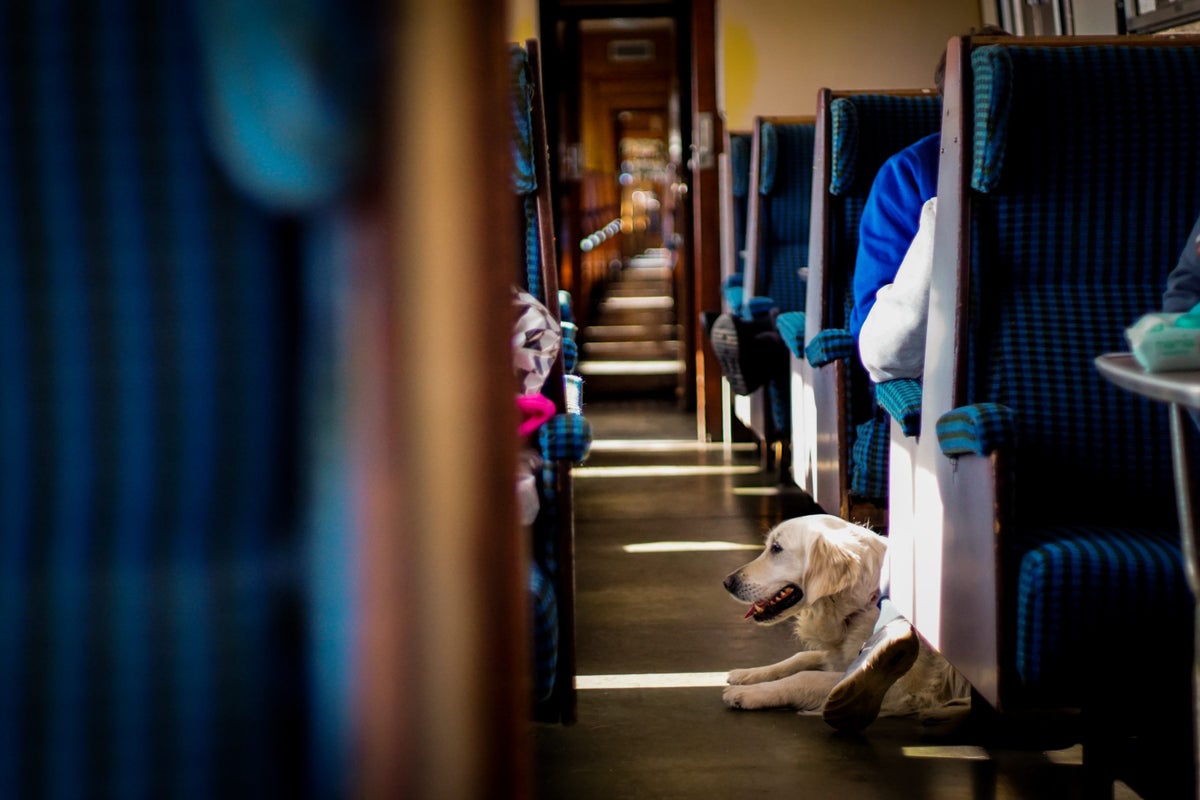
Motion Sickness
Heath and documentation requirements, pet identification, nearest vet, relief breaks, checklist for what to take on board, mainline routes where pets are not permitted, paperwork and health requirements, booking procedure, train systems that allow pets, weight of the carrier and your pet, ventilation, what about large pets, final thoughts.
We may be compensated when you click on product links, such as credit cards, from one or more of our advertising partners. Terms apply to the offers below. See our Advertising Policy for more about our partners, how we make money, and our rating methodology. Opinions and recommendations are ours alone.
When planning your next trip within the U.S., you may not want to leave your 4-legged friend at home. Thankfully, with many train services now allowing small pets to be carried on board, there are alternative options to flying or driving.
Train travel can be much less stressful than flying for both pet and owner, with shorter check-in times and the comfort of having your pet on your lap for the entire journey, rather than under your seat or in the hold compartment.
There’s also the cost to consider, with the likes of Delta Air Lines and United charging from $125 to transport your pet as carry-on, versus Amtrak, where pets can be carried for just $26.
This helpful guide will help you plan for your trip and rounds-up the pet policies for each train operator listed by individual state.
This information relates to pets-only, not officially trained service dogs that are governed under the Americans with Disabilities Act and are permitted to go “where the public is normally allowed to go”.
Things to Consider Pre-Travel
To ensure the well-being of your faithful friend, and that you’re adhering to certain rules, there are some things to consider when planning to take your pet on board a train.
Like humans, some animals can get motion sickness, so it’s advisable to test out some short journeys before embarking on a 7-hour train ride. Be sure to have plenty of water with you to avoid your pet becoming dehydrated as this will only make the motion sickness worse.
As many train operators only permit small pets to be transported within a pet carrier, you’ll need to test out how your pet responds to being inside a cage for long periods.
Many train operators such as Amtrak state that the pet must not be disruptive, so train travel may not be suitable if you have a dog that barks continuously when in their pet carrier.
On local train services, documentation is not likely to be requested by train personnel; however, when using Amtrak services , passengers must sign to certify that their pet is up-to-date with their vaccinations.
To transport a pet between states, most states require that the pet have a recent Certificate of Veterinary Inspection (CVI), which indicates that the pet is clear of rabies and other infectious diseases. Each state has different rules as to when the certificate should be obtained before entering a state, but the most common time period is within 30 days before entry.
Although not mandatory in the U.S., you may want to consider getting your pet micro-chipped for their safety. If your pet became lost in an unknown destination, the likelihood of tracking them down would be far greater with a microchip. You should also make sure that they have a collar with your contact number.
Even if you’re only taking a short trip, it’s still wise to familiarize yourself with your nearest vet just in case they require urgent care while traveling.
If you’re traveling on a long train ride, then you’ll need to ensure there are sufficient relief breaks along your route. Check with the train operator to see if they have any scheduled stops that are more than just a couple of minutes so that you have time to relieve your pet in a suitable location.
- Vet contact details.
- Well-ventilated pet carrier.
- Collar and leash.
- Blankets/jacket if the journey is cold.
- Chew toys for inside their carrier.
- Snacks, food, and plenty of water.
- Food and drink bowls.
- Certificate of Veterinary Inspection (CVI).
Hot Tip: Keep all of your pet’s important items organized with a great dog travel bag .
Amtrak Pet Policy
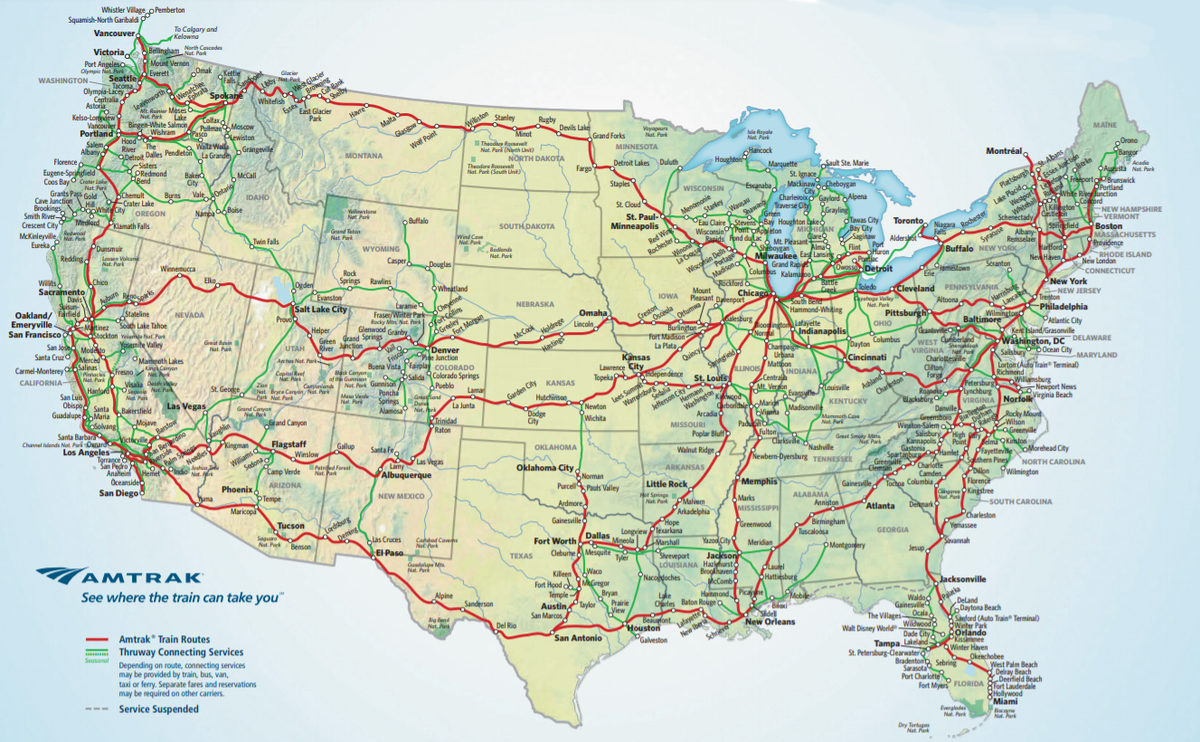
Amtrak permits passengers to bring dogs or cats (up to 20 pounds) onboard many of its train journeys that are 7 hours or less. Pets are not permitted on specific mainline routes or Thruway connecting services (green routes on the above map and detailed by state in the table below).

- Auto Train : Lorton, VA (Washington, DC) – Sanford, FL (Orlando)
- Capital Corridor : Auburn – Sacramento – Emeryville (San Francisco) – Oakland – San Jose
- Keystone Service : NYC – Philadelphia – Paoli – Downingtown – Lancaster – Harrisburg
- Pacific Surfliner : San Luis Obispo – Santa Barbara – Los Angeles – Anaheim – San Diego
- Pennsylvanian : New York – Philadelphia – Lancaster – Harrisburg – Altoona – Pittsburgh
- San Joaquins : San Francisco Bay Area / Sacramento – Bakersfield / Southern California
Amtrak provides the following guidelines and rules for bringing your pet on board:
- Pets must be booked on a reservation with a maximum of 5 pets permitted on each train service, available on a first-come, first-serve basis.
- Only 1 pet is permitted per passenger, and they may only ride in coach class, rather than business class or any sleeper services.
- Pets must be transported in a pet carrier measuring no more than 19 x 14 x 10.5 inches and must be well ventilated and leak proof. The total weight of the pet inside the carrier cannot exceed 20 pounds.
- Pet carriers count towards a passenger’s carry-on allowance and must be placed under the passenger’s seat. Pets are not permitted outside of the carrier for the duration of the journey or in stations.
Hot Tip: The following routes designate pet-specific coaches; whereas, for other pet-friendly routes, pets are permitted in any coach cars: Amtrak Cascades, Blue Water, Carl Sandburg, Hiawatha, Illini, Illinois Zephyr, Lincoln Service, Missouri River Runner, Pere Marquette, Saluki, and Wolverine.
- Passengers must sign a Pet Release and Indemnification Agreement for each segment of the journey.
- Passengers must check-in at the ticket desk no later than 30 minutes before the train departs, to allow time to complete the pet release paperwork.
- Pets must be 8 weeks or older to travel on Amtrak services and be odorless and non-disruptive to other passengers.
- Passengers will certify that their pet is up-to-date with all required vaccinations before travel.
Pets can be booked onto a reservation at Amtrak.com or by calling 800-USA-RAIL. Bookings can also be made in person at an Amtrak ticket desk.
Hot Tip: Pets can travel on board Amtrak services for $26 .
Hot Tip: Need ideas on the best trips to take with your furry friend? Check out our piece on the 15 Most and Least Pet-Friendly Vacation Spots in the U.S. .
Pet Carriers
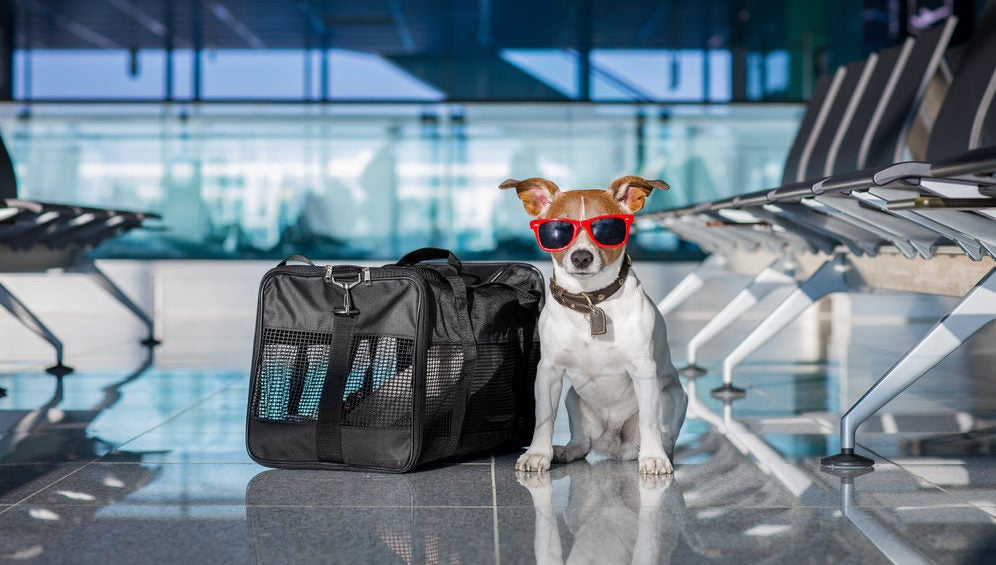
When looking for the perfect pet carrier, there a few things you should consider.
Amtrak and some other train operators have weight restrictions that are usually the weight of your pet and the carrier combined. If your pet is on the heavier side, you’ll need to find a lightweight, soft carrier that is also robust enough to accommodate the weight of your pet.
Choosing the correct size of carrier for your pet is an important decision. Too big and your pet could move around, making it difficult to balance and carry. Too small and it would be uncomfortable for your pet, restricting space to stand up or stretch. As a rule of thumb, your pet carrier should be around 1.5 times the size of your pet.
Traveling on a train can be hot at times, so it’s advisable to choose a pet carrier that has mesh sides to allow airflow to keep your faithful friend cool.
Owners have the choice between hard and soft shell pet carriers, and the decision will depend entirely on your circumstances and preference. Hardshell carriers are more robust, provide more protection, and are easier to keep clean; whereas, soft carriers can offer more comfort, are lighter, and easier to store.
Hot Tip: Make sure you’re earning points for your pet purchases. Check out our guide to the best credit cards to use for pet expenses.
As you can see from the table above, most train operators stipulate that only “small pets” may be carried on board, so train travel is unfortunately not yet widely accessible to larger animals.
However, some passengers do try to bend the rules of certain operators such as the New York Subway that states “No person may bring any animal on or into any conveyance or facility unless enclosed in a container and carried in a manner which would not annoy other passengers.”
Over the years, there’s been controversy over the number of pet-related deaths during transit in both the cabin and cargo hold of an airplane; in fact, we did a whole study on the best airlines for pets for that exact reason. Traveling on a train with your pet can be a more relaxed and safer mode of transport for your pet.
Some pets can struggle with the pressure from an airplane’s increased altitude, causing issues with breathing. In fact, this has caused some airlines to prohibit the hold transportation of snub-nosed breeds, such as pugs and bulldogs.
If you’ve got a small pet that you would like to travel with you, train travel is the ideal mode of transport, being relatively cheap and safe. Looking for more information on traveling with your 4-legged friend? Explore our ultimate guide on traveling with your pet .
Frequently Asked Questions
Are pets allowed on trains.
In the United States, pets are allowed on some trains and it is becoming increasingly common that pets are permitted. Amtrak allows pets up to 20 pounds on many routes (with restrictions on certain routes). The table above lists details of pet policies for train operators within each state.
How do you travel with a cat on a train?
To take your cat on a train, they should be inside a suitable pet carrier that is well ventilated and leak-free. This should be placed under your seat or kept on your lap. Ensure you have plenty of water and are able to stop for relief breaks if the journey is long.
How do you travel with a dog on a train?
When traveling with a dog on a train, they should be inside a suitable pet carrier that is well ventilated and leak-free. This should be placed under your seat or kept on your lap. Ensure you have plenty of water and are able to stop for relief breaks if the journey is long. Your dog should not cause any disruption to other passengers, otherwise you may be asked to disembark.
Can dogs travel on trains in the U.S.?
Some U.S. train operators, such as Amtrak, allow pets on board. Dogs up to 20 pounds are permitted to ride on many routes (some restricted routes apply) providing they remain within an enclosed pet carrier for the duration of the journey.
Was this page helpful?
About Amar Hussain
Amar is an avid traveler and tester of products. He has spent the last 13 years traveling all 7 continents and has put the products to the test on each of them. He has contributed to publications including Forbes, the Huffington Post, and more.
INSIDERS ONLY: UP PULSE ™

Get the latest travel tips, crucial news, flight & hotel deal alerts...
Plus — expert strategies to maximize your points & miles by joining our (free) newsletter.
We respect your privacy . This site is protected by reCAPTCHA. Google's privacy policy and terms of service apply.
Related Posts
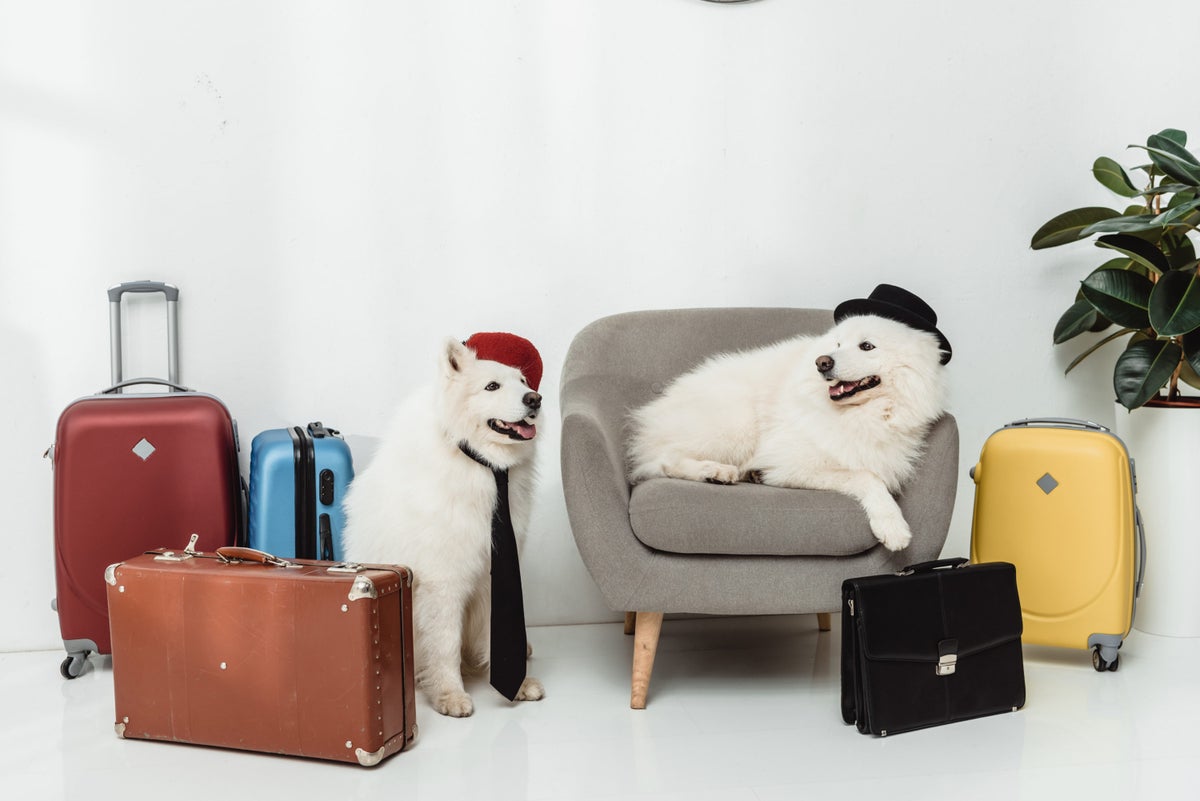
UP's Bonus Valuation
This bonus value is an estimated valuation calculated by UP after analyzing redemption options, transfer partners, award availability and how much UP would pay to buy these points.
Get smartphone savvy the easy way — join our seven-day email challenge to receive helpful tips each day.
AARP daily Crossword Puzzle
Hotels with AARP discounts
Life Insurance
AARP Dental Insurance Plans
AARP MEMBERSHIP — $12 FOR YOUR FIRST YEAR WHEN YOU SIGN UP FOR AUTOMATIC RENEWAL
Get instant access to members-only products and hundreds of discounts, a free second membership, and a subscription to AARP the Magazine.
- right_container
Work & Jobs
Social Security
AARP en Español
- Membership & Benefits
- AARP Rewards
- AARP Rewards %{points}%
Conditions & Treatments
Drugs & Supplements
Health Care & Coverage
Health Benefits

Staying Fit
Your Personalized Guide to Fitness

AARP Hearing Center
Ways To Improve Your Hearing

Brain Health Resources
Tools and Explainers on Brain Health

A Retreat For Those Struggling
Scams & Fraud
Personal Finance
Money Benefits

View and Report Scams in Your Area

AARP Foundation Tax-Aide
Free Tax Preparation Assistance

AARP Money Map
Get Your Finances Back on Track

How to Protect What You Collect
Small Business
Age Discrimination

Flexible Work
Freelance Jobs You Can Do From Home

AARP Skills Builder
Online Courses to Boost Your Career

31 Great Ways to Boost Your Career

ON-DEMAND WEBINARS
Tips to Enhance Your Job Search

Get More out of Your Benefits

When to Start Taking Social Security

10 Top Social Security FAQs

Social Security Benefits Calculator

Medicare Made Easy
Original vs. Medicare Advantage

Enrollment Guide
Step-by-Step Tool for First-Timers

Prescription Drugs
9 Biggest Changes Under New Rx Law

Medicare FAQs
Quick Answers to Your Top Questions
Care at Home
Financial & Legal
Life Balance

LONG-TERM CARE
Understanding Basics of LTC Insurance

State Guides
Assistance and Services in Your Area

Prepare to Care Guides
How to Develop a Caregiving Plan

End of Life
How to Cope With Grief, Loss
Recently Played
Word & Trivia
Atari® & Retro
Members Only
Staying Sharp
Mobile Apps
More About Games

Right Again! Trivia

Right Again! Trivia – Sports

Atari® Video Games

Throwback Thursday Crossword
Travel Tips
Vacation Ideas
Destinations
Travel Benefits

Beach vacation ideas
Vacations for Sun and Fun

Plan Ahead for Tourist Taxes

AARP City Guide
Discover Seattle

25 Ways to Save on Your Vacation
Entertainment & Style
Family & Relationships
Personal Tech
Home & Living
Celebrities
Beauty & Style

TV for Grownups
Best Reality TV Shows for Grownups

Robert De Niro Reflects on His Life

Looking Back
50 World Changers Turning 50

Sex & Dating
Spice Up Your Love Life

Navigate All Kinds of Connections

Life & Home
Couple Creates Their Forever Home

Store Medical Records on Your Phone?

Maximize the Life of Your Phone Battery

Virtual Community Center
Join Free Tech Help Events

Create a Hygge Haven

Soups to Comfort Your Soul

Your Ultimate Guide to Mulching
Driver Safety
Maintenance & Safety
Trends & Technology

AARP Smart Guide
How to Keep Your Car Running

We Need To Talk
Assess Your Loved One's Driving Skills

AARP Smart Driver Course

Building Resilience in Difficult Times

Tips for Finding Your Calm

Weight Loss After 50 Challenge

Cautionary Tales of Today's Biggest Scams

7 Top Podcasts for Armchair Travelers

Jean Chatzky: ‘Closing the Savings Gap’

Quick Digest of Today's Top News

AARP Top Tips for Navigating Life

Get Moving With Our Workout Series
You are now leaving AARP.org and going to a website that is not operated by AARP. A different privacy policy and terms of service will apply.
Go to Series Main Page
All Aboard: Tips for Traveling With Your Pet on a Train
Here’s what you need to know before and after you board.

Hilary Nangle,
We love our pets, and we love traveling with them . And taking the train can be an affordable and easy way to travel around the country.
But boarding with your furry friend requires a good amount of planning and preparation. Here’s what you need to know about traveling with your pet on a train. Note: These rules do not apply to service animals.

AARP Membership — $12 for your first year when you sign up for Automatic Renewal
Before you book your train trip
First, not all trains allow pets. While some local, regional or scenic trains do, the fees and rules vary. For example, some trains limit pets to specific animals, have weight limits or require that pets travel in a carrier. So, it’s important to do your homework.
Amtrak offers the most routes across the United States, and pets are welcome on many of the trains. You can travel with one dog or cat (sorry birds, bunnies, gerbils and ferrets) weighing a maximum of 20 pounds, including the carrier. Your pet will also have to stay in that carrier under your seat (more on that later).
You can travel up to seven hours with your pet, but that includes transfer time if changing trains. If it’s just you and your pet, you may want to pack some snacks for both of you because pets can’t go in a café or dining car and you can’t leave your pet alone under your seat.
Pets also are not allowed in first class, sleeper cars and non-Acela business class.
You will have to fill out an online pet release and indemnification agreement before traveling. Among the requirements: Your pet must be at least 8 weeks old and up to date on vaccinations, as well as odorless, harmless and nondisruptive during travel.
If these requirements sound too strict for your furry companion, keep in mind that Amtrak has the right to refuse or remove your pet from the train if any policies are violated.
Prepare your pet for the train ride
If your pet checks all the boxes, the next step is to make sure you have everything you need to board the train.
Amtrak requires that your pet can sit and lie down without touching the sides of a leak-proof and well-ventilated carrier that doesn’t exceed 19 inches long by 14 inches wide by 10.5 inches high.
ARTICLE CONTINUES AFTER ADVERTISEMENT
Pets traveling on the Alaska Railroad must be in an airline-approved kennel and have to ride in the baggage car.
Before your trip, make sure your pet is acclimated to the carrier. And if possible, take your pet to a train station so your pet can become more familiar with the sounds and sights. Even better, consider taking a short train ride with your pet to help them become more comfortable with the train’s noises and movements.
Holland America Line
Up to $200 onboard credit on select cruises
Request your pet’s vaccination and other records from the veterinarian in case of an emergency. If your pet is anxious or tends to bark at unknown sounds, ask the vet about ways to keep your pet calm and quiet during the ride. Ask also about motion sickness preventives and getting a microchip implanted into your pet in case it runs off in an unknown destination.
When packing, your pet’s carrier counts as one carry-on so plan strategically for the other. A backpack or shoulder bag allows you to keep your hands free for handling your pet. Pack a collapsible water bowl, water, treats and a favorite (nonsqueaky) toy to keep your pet comfortable during the trip. It’s a good idea to line the carrier with an absorbent pad and bring bags and an extra towel to clean up any accidents that may happen while on the train.
Plan to arrive at least 45 minutes before boarding at any staffed Amtrak station. Once you’re there, check in with the ticket office where agents will validate your pet’s eligibility and paperwork. At unstaffed stations, the train conductor will do this. Note: Your pet must always remain in the closed carrier while in the station and on the train. Pets are not allowed inside Amtrak station lounges or first-class waiting areas.

Tips for traveling on the train
The route you are traveling will determine where you sit. Some trains have a pet-friendly coach car; others allow you to sit in any coach car. If the train has a pet-friendly quiet car, consider sitting there as there will be less noise and fewer distractions. If possible, avoid peak travel times and rush hours for the best experience.
To help avoid motion sickness, feed your pet a light meal three hours before departure .
A tired pet is a happy pet, so exercise your pet before boarding.
And lastly, keep an eye on the schedule so you’ll have all the time you need to disembark.
Hilary Nangle has written for many publications, including Snow, Ski, Westways and Yankee. She’s also the author of four guidebooks to her home state in the Moon series: Maine, Coastal Maine, Acadia National Park and the forthcoming Best of Acadia.
Discover AARP Members Only Access
Already a Member? Login
MORE FROM AARP

Quiz: Pets and Your Health
Find out what you know about the benefits
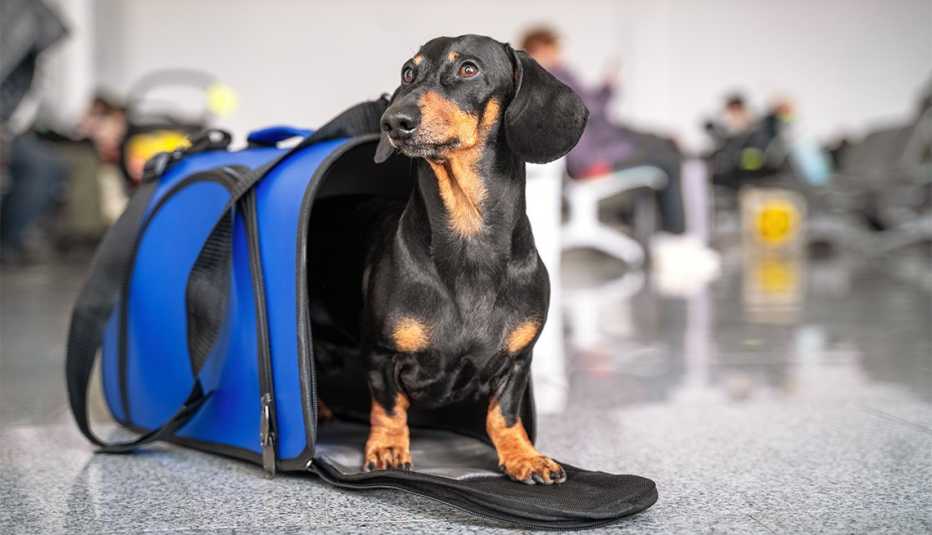
Quiz: How Much Do You Know About Traveling With Your Pet?
We have the purrfect aptitude test your smarts
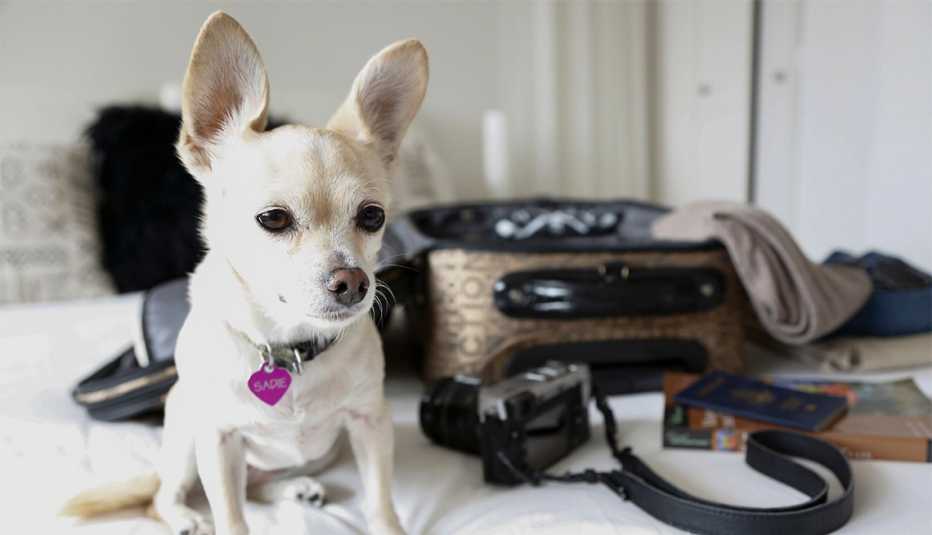
Ideas for Dog-Friendly Vacations Around the U.S.
Discover the best places to stay and play if you love traveling with your pup
Or Call: 1-800-675-4318
Enter a valid from location
Enter a valid to location
Enter a valid departing date
Enter a valid returning date
Age of children:
Child under 2 must either sit in laps or in seats:
+ Add Another Flight
Enter a valid destination location
Enter a valid checking in date
Enter a valid checking out date
Occupants of Room
Occupants of Room 1:
Occupants of Room 2:
Occupants of Room 3:
Occupants of Room 4:
Occupants of Room 5:
Occupants of Room 6:
Occupants of Room 7:
Occupants of Room 8:
Enter a valid date
You didn't specify child's age
There are children in room 1 without an adult
You didn't specify child's age for room 1
There are children in room 2 without an adult
You didn't specify child's age in room 2
There are children in room 3 without an adult
You didn't specify child's age in room 3
There are children in room 4 without an adult
You didn't specify child's age in room 4
There are children in room 5 without an adult
You didn't specify child's age in room 5
You have more than 6 people total
Please select a trip duration less than 28 days
There must be at least 1 traveler (age 12+) for each infant in a lap
Enter a valid From location
Enter a valid start date
Enter a valid drop location
Enter a valid drop off date
Select a valid to location
Select a month
Enter a valid going to location
Enter a valid from date
Enter a valid to date
AARP Value & Member Benefits

Hurtigruten Expeditions
5% off cruise fares and a €100 per person onboard credit

AARP Vacation Ideas
Ideas for every type of trip – from cruises to road trips

AARP Travel Center Powered by Expedia: Car Rentals
Up to 30% off select car rentals

AARP® Staying Sharp®
Activities, recipes, challenges and more with full access to AARP Staying Sharp®
SAVE MONEY WITH THESE LIMITED-TIME OFFERS
- United States
- Restaurants & Bars
- Dog Beaches in the U.S. | Dog Friendly Beaches
- Dog Beaches — Canada
- Pet Friendly Campgrounds and RV Parks U.S.
- Pet-Friendly Campgrounds — Canada
- Pets in U.S. National Parks & Forests
- Pet Friendly State Parks and Forests U.S.
- Dog Parks — United States
- Dog Parks — Canada
- Pet-Friendly Shopping Malls
- Pet-Friendly Activities & Attractions
- Private Jet Charters
- Pet-Friendly Airports — United States
- Animal and Pet Relief Areas at Airports in Canada
- International Pet Travel
- Train Travel
- R.V. Travel
- Boat Travel
- Pet Travel Tips
- Pet Evacuation & Emergency Shelters
- Pet Friendly Timeshares and Timeshare Resorts
- Hotel Chains Pet Policies
- Travel with Pet Birds
- Pet Adoption / Animal Rescue
- Purchasing a Pet Online
- Pet Travel Products
- Pet Friendly Travel in the News
- Friends of PetFriendlyTravel.com
- List Your Property on PetFriendlyTravel.com
- Property Listing FAQs
- Testimonials
- Customer Log In / Register
Cart is empty

Travel with Pets by Train
Pet travel by train can be much safer and less stressful than taking your pet on an airplane. Air travel can put your pet at risk due to changes in air quality, air circulation, temperature, cabin pressure, and other environmental issues that could be harmful to your pet’s health. In fact, select short-nosed breeds are not allowed to travel on certain airlines because of respiratory issues that may make it especially difficult for them to breathe properly under the stress and environment of flying. On Amtrak there’s no restrictions on traveling with short-nosed breeds.
Traveling with your pet by train can also be a much cheaper alternative than flying or even driving. In addition, you won’t have to worry about having to produce proof of vaccinations, a health certificate, or any other type of paperwork. In fact, most trains only require that your pet be able to travel in a pet carrier that can fit on your lap, or underneath your seat.
Train Travel in the United States
Amtrak is a passenger railroad service that provides medium- and long-distance intercity service in the contiguous United States and to nine Canadian cities. Amtrak welcomes dogs and cats up to 20 pounds (combined weight of pet and carrier) for trips up to seven hours on most routes. Only dogs and cats are allowed to travel as pets. Pets are permitted in Coach Class and Acela Business Class (pets are not allowed in Acela First Class seating, First Class private rooms, non-Acela Business Class, food service cars or other accommodations). Reservations with pets are limited to seven hours total travel time, including transfer time between trains on multiple-segment trips.
Not all Amtrak trains allow pets, and some trains don’t accept pets on all services. For example, if travelling between New York and Washington, the Northeast Regional trains accept pets on all services. However, the Acela Express only accepts pets on weekend and holiday services, while some other trains don’t allow pets anytime. Some routes designate a specific Coach car for pets: Amtrak Cascades, Carl Sandburg, Illinois Zephyr, Illini, Lincoln Service, Saluki, Pere Marquette, Wolverine, Blue Water, Hiawatha and Missouri River Runner. On other pet friendly routes, you and your pet may ride in any Coach car. Find info on which Amtrak trains allow pets .
Pet travel by train in Canada is not available on Adirondack, Maple Leaf and Amtrak Cascades; not available on Auto Train, Keystone Service, Pennsylvanian, San Joaquins, Capitol Corridor Pacific Surfliner or Thruway Connecting Services. Amtrak does not ship pets or allow them to travel as checked baggage — a pet must travel with a human. Read more about Amtrak’s pet policy .
How to Travel on Amtrak Trains With a Dog in 2024 Find out everything you need to know about how to travel on Amtrak with a dog, from the rules for travelling with a pet on Amtrak to how much it costs and how to make a booking.
Train Travel in Canada
VIA Rail Canada operates 475 trains per week in eight Canadian provinces (exceptions are Newfoundland and Labrador and Prince Edward Island). VIA Rail Canada allows pets – only small dogs and cats – to travel in cars with their owners as long as the animals are small enough to fit comfortably in a carrier that meets VIA Rail carrier standards. The total weight of the carrier and animal must not exceed 10 kilograms (22 lb.). This pet travel by train policy applies only on Corridor trains (Québec City to Windsor). Pets are prohibited from traveling with passengers on The Maple Leaf (Toronto – New York) Amtrak train. Read more here .
Pets may travel as a checked item in the baggage car as long as the pet is on the same train as their owner and is claimed immediately upon arrival. Dogs, cats and small rodents (hamsters, guinea pigs, rabbits, etc.) are the only animals allowed in baggage cars. Birds cannot be checked. From June 1 to September 30, baggage cars cannot transport animals due to lack of proper ventilation. Usually, pets may be transported year-round on the Ocean (Montréal – Halifax), as all cars are air-conditioned. Certain provinces and regions refuse pitbulls, therefore, VIA Rail does not accept this breed of dog system wide. Read more here .
Train Travel in Europe
In general, pets are allowed to travel with you on most European trains for free if they are in a carrier. Larger pets need to be muzzled and kept on a leash and usually travel for a reduced rate. However, the rules for traveling with a pet on a train vary from train company to company, country to country. For instance, some countries do not allow large dogs to travel on trains, only small dogs in a container. Always check the details for the specific train company before planning your trip. Please note: Guide and assistance dogs are the only animals allowed on Eurostar.
Dogs, cats and ferrets traveling by train across country borders must have a minimum of one current rabies vaccination administered after a microchip is implanted and no sooner than 21 days prior to travel. If your pet has had more than one rabies vaccination given after the chip was implanted and all were kept current, you do not need to wait for 21 days after the booster. Dogs, cats and ferrets must travel with an EU Pet Passport issued by your veterinarian.
More Information
All Aboard: Tips for Traveling With Your Pet on a Train Here’s what you need to know before and after you board.
Pups Onboard: Why Trains Are a Great Way to Travel With Your Dog(s) The pugs Rufus and Hamilton have tried every mode of transportation but nothing beats a ride on the rails.
Can I Take Fido? Top Tips for Riding European Trains With Dogs Trains are by far the best option for traveling with your dog in Europe and are relatively inexpensive.
Are Dogs Allowed on Trains in Europe? Find out which trains in Europe allow dogs and what are the rules for dogs on trains.
Top 10 Pet-Friendly Trains in Europe & North America Tips for taking your pet on trains in Europe and North America, including Amtrak and VIA Rail Canada.
Traveling in Italy with Pets Find out the essentials of navigating Italy’s rail system with pets.
Dogs on Public Transport in Australia Melbourne public transport is dog-friendly and Sydney allows small pets on light rail, buses and ferries inside a carrier. Brisbane allows dogs on board CityCats and ferries, but are banned on trains and buses.
Find a Pet Friendly Train
Please select a country: — COUNTRY — Austria Belgium Bulgaria Canada Denmark Finland France — France-Belgium — France-Italy — France-Switzerland Germany Ireland Italy Netherlands — Netherlands-Belgium Norway Portugal Spain Sweden Switzerland United Kingdom United States — -Amtrak- — Alaska — California — Colorado — Connecticut — Florida — Georgia — Illinois — Massachusettes — New Jersey — New York — Oregon — Texas — Virginia — Washington
Pet Friendly Travel, LLC
- Privacy Policy
- Terms of Service
Paws on the Rails: The Ultimate Guide to Pets in Train Journeys
Traveling by train is a unique experience, filled with the romance of railroads and picturesque landscapes unfolding before your eyes. But have you ever wondered what it would be like to bring your pet along for the ride?
Train journeys with pets can be a delight, giving a new meaning to the phrase "adventure with your best friend." But they can also be challenging, especially if you're not prepared.
Preparation: The Key to Successful Pet Travel
Before you even think about boarding a train with your pet, you'll need to do some groundwork. First, you'll need to verify the pet travel policies of the train company. Not all trains are pet-friendly, and even those that are often have strict rules about the size and type of pets allowed.
Your dog's health should be your top priority when traveling. Keep in mind that travel can be stressful for animals. If your dog is in poor health or has not been properly socialized, a train journey might not be the best idea.
Recognize Your Pet's Needs
Cats and dogs, unlike humans, recognize faces differently. They rely more on their senses, such as smell, to identify their surroundings and people. In unfamiliar settings, they can become anxious. Thus, bringing familiar toys and blankets can create a sense of comfort and familiarity during a train journey.
Pets also need ample space to stretch and play. One interesting observation is how dogs shake their toys . This behavior is not just play but also exercise and a way to alleviate boredom. Ensure there is sufficient room for such activities.
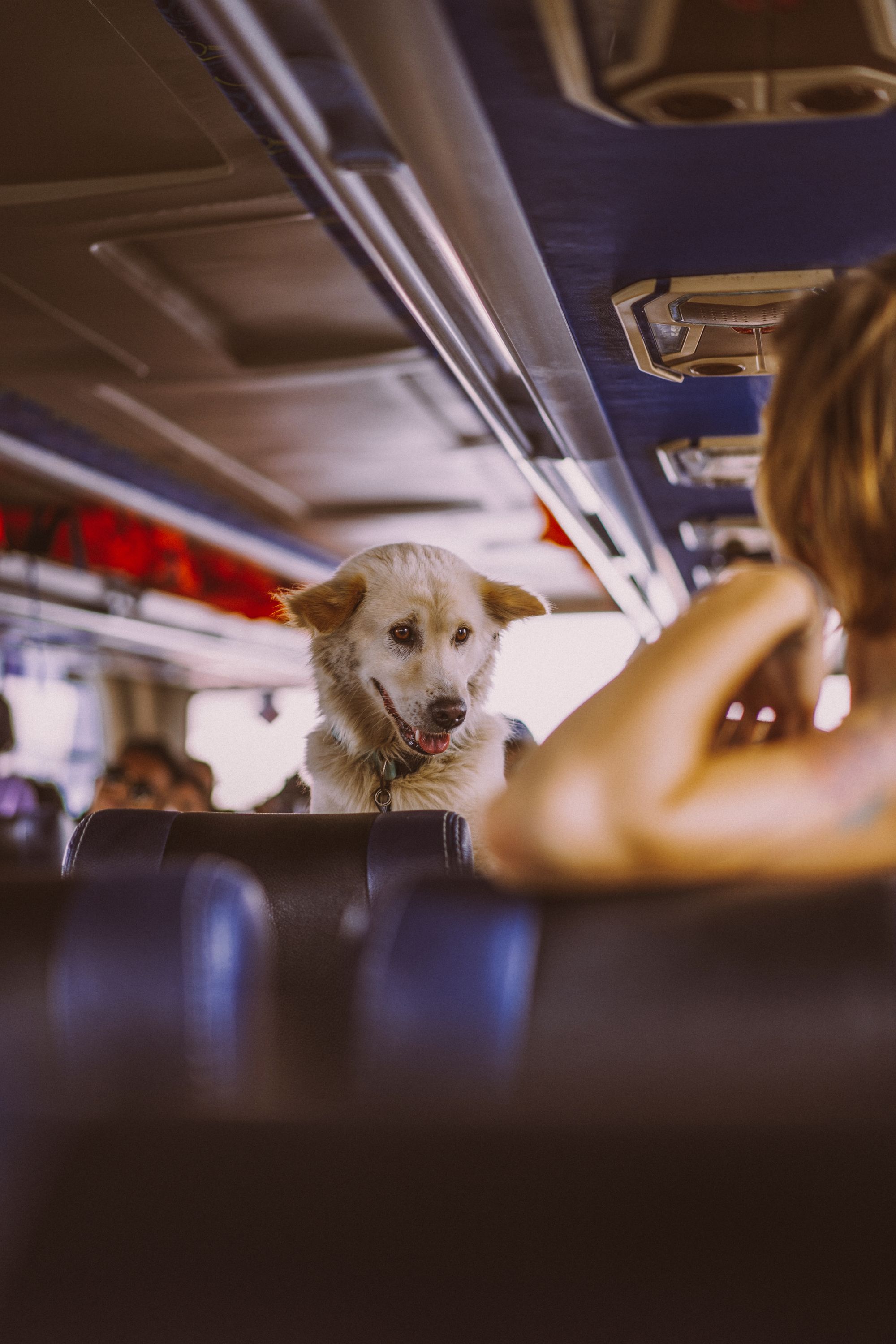
Tips and Tricks for Traveling with Pets on Trains
When it comes to pet-friendly train travel, it's essential to keep your pet comfortable and entertained throughout the journey. Here are a few tips:
- Bring their favorite toys, which will be familiar and provide comfort and entertainment.
- Pack enough food and water for the journey. Train food is not always pet-friendly!
- Make sure you have a comfortable carrier. Some train companies require pets to be in a carrier at all times.
Remember, while the journey can be fun with your dog , it can also be stressful for them. Keep a close eye on their behavior and mood.
The Role of Rescue Dogs and Public Transportation
Train travel isn't just for pet dogs. Rescue dogs also frequently use public transportation. They are trained to be comfortable in many different environments, including busy trains. Stories of rescue dogs traveling by train can be heartwarming examples of pets and people sharing public spaces.
Dog Restaurant Etiquette
While this guide is about train journeys, it's essential to mention dog restaurant etiquette . Many train stations have restaurants or food courts. If you're planning a longer journey, you might want to grab a bite to eat before boarding or during a stopover.
In many cases, dogs are allowed in outdoor dining areas. Always remember to keep your dog on a leash and discourage them from begging for food or bothering other customers.
The Joys of Traveling with Pets
Having your pet by your side as you traverse the country can be an incredible experience. The memories you create will last a lifetime, and the bond you form with your pet can be strengthened.
Pets on trains is not only about getting from one place to another. It's about the journey, the shared experiences, and the joy of exploring new places with your furry friend.
Train journeys with pets might require a bit more planning and preparation, but the rewards are immeasurable. So why not bring your pet along the next time you ride the rails? After all, adventures are always better when shared with a friend.
Essential Pet Travel Accessories for Train Journeys
Equipping yourself with the right pet travel accessories can make your train journey smoother. A comfortable carrier is essential. You might also want to consider bringing a portable water dish, a blanket, and a few toys to keep your pet entertained.
Leashes are a must for dogs. When you're moving through crowded train stations, having your pet securely leashed can prevent mishaps.
And don't forget the basics: food and water. Remember to bring a supply of your pet's regular food, as changing diets abruptly can upset their stomach.
Understanding Animal Behavior on Trains
Traveling can be stressful for animals. While some pets might enjoy the journey, others might find the experience scary or overwhelming. It's important to understand your pet's behavior and body language to ensure they're comfortable.
Dogs are particularly expressive, often communicating through their tails. A wagging tail often means they're happy, while a tucked tail can indicate fear or anxiety. If your dog is showing signs of stress, do your best to comfort them.
Cats, on the other hand, might prefer to hide in their carrier. Respect their need for privacy and quiet during the journey.
Navigating Pet-Friendly Railways Across the Globe
If you're planning to travel internationally with your pet, you're in luck. Many countries have pet-friendly railways.
For instance, in Europe, many train companies allow small pets to travel for free. Larger dogs might need a ticket, and the rules can vary from one country to another.
In the US, Amtrak allows small pets on many of their routes, provided they are in a carrier and meet certain weight requirements.
Asian countries also have varying rules. For example, in Japan, pets are allowed on trains as long as they are in a carrier.
Wherever you're planning to travel, it's best to check the train company's pet policy in advance.
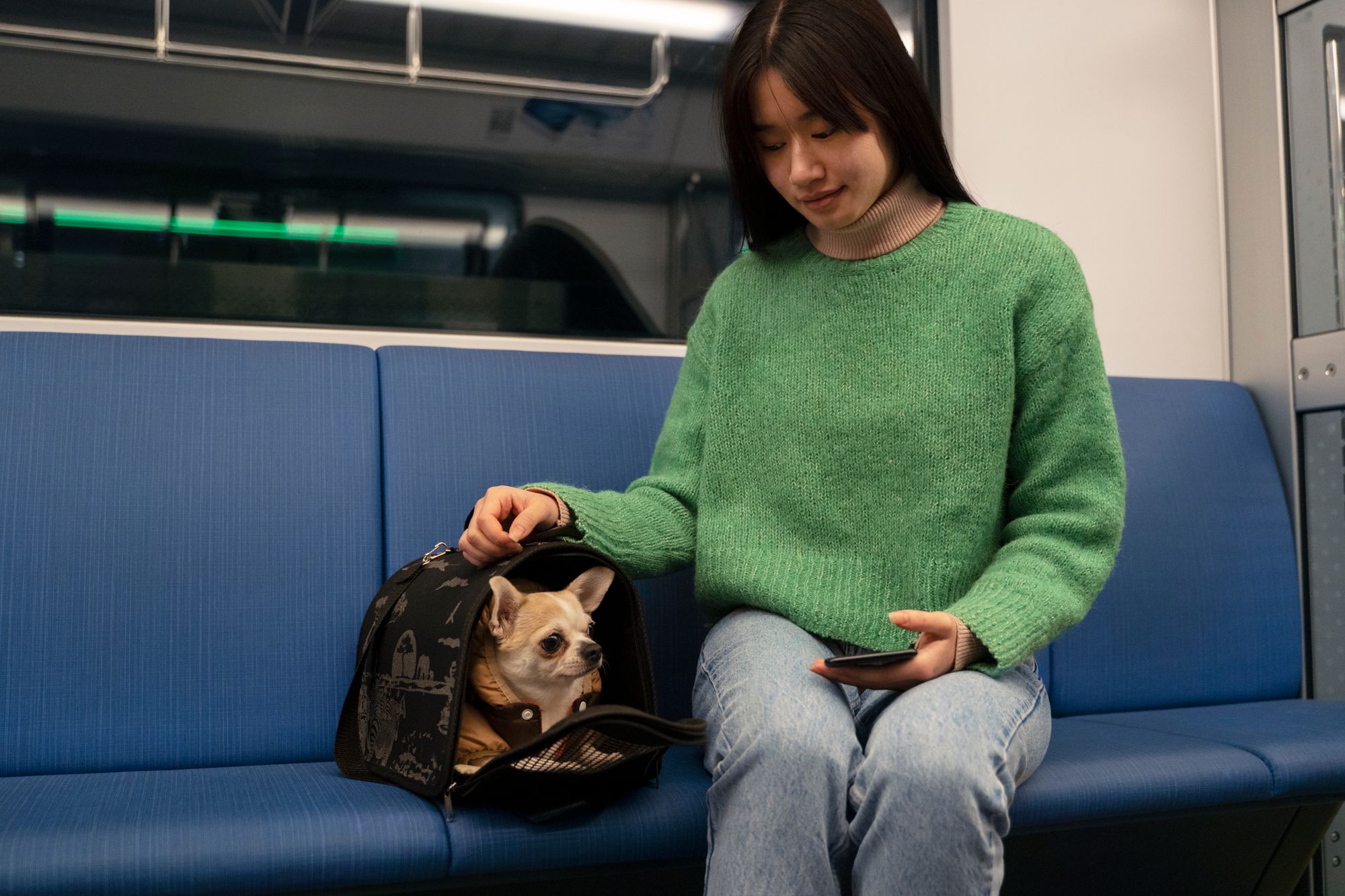
A Deeper Dive into Pet Travel Policies
Just as with humans, different train companies have varying policies regarding the travel of pets. The critical step is to check the specifics of these pet travel policies before planning your trip. This includes looking at things such as:
- Allowed pet types: Some trains only permit dogs, while others may also allow cats or other small pets.
- Size restrictions: There may be limits on the size of the pet or the carrier they are in.
- Documentation: Certain companies may require proof of vaccinations or health certificates.
Knowing these details beforehand will prevent any hiccups during your travel.
Comfortable Pet Travel: Ensuring a Smooth Journey
Just as you want a comfortable seat and enough legroom, your pet too needs a cozy spot during the journey. Comfortable pet travel is all about ensuring your pet has enough space, a comfortable temperature, and isn't exposed to excessive noise or disturbances.
The type of carrier you choose is crucial here. Make sure it is well-ventilated, secure, and big enough for your pet to move around comfortably. Also, adding a favorite blanket or toy can help create a familiar environment, reducing potential stress.
Train Pet Etiquette: Dos and Don'ts
Train journeys with pets call for a certain train pet etiquette. Here are some pointers:
- Keep your pet in their carrier unless allowed otherwise.
- Respect other passengers' space. Not everyone is comfortable around animals.
- Keep noise to a minimum. If your pet is prone to barking or making noise, train travel may not be the best option.
- Clean up after your pet. Always have waste bags handy.
Remember, the goal is to make the journey enjoyable for everyone, including other passengers.
Pet Transport on Trains: An Adventure Awaiting
Pet transport on trains can be a fantastic experience. There's something magical about watching the world pass by through the window with your pet by your side. It's a journey filled with new scents and sights for them, and a unique bonding opportunity for both of you.
So next time you're planning a train journey, don't hesitate to bring your pet along. It's not just about reaching your destination—it's about enjoying the ride. With a bit of preparation, patience, and lots of love, you and your pet can embark on an unforgettable railway adventure. Paws on the rails, and let the journey begin!
Introducing FI Dog Collars: A Must-Have for Pet Train Travel
Whether you're planning a short trip or an extended journey on the rails with your pet, one accessory you should definitely consider is the FI dog collar. This high-tech gadget is a fantastic addition to your pet travel kit and aligns perfectly with the various aspects of pet train travel we've discussed.
The Utility of FI Collars in Following Pet Travel Policies
One of the key aspects to consider when planning a train journey with your pet is adhering to the pet travel policies of different rail companies. FI dog collars, with their advanced tracking feature, can provide an extra layer of assurance that your pet is safe and secure during your journey.
If a train company requires that your pet stay in a carrier throughout the journey, you can monitor their activity levels via the FI collar. This data can help you understand if they're restless or anxious, allowing you to comfort them accordingly.
Ensuring Comfortable Pet Travel with FI Collars
When it comes to comfortable pet travel, it's all about understanding and responding to your pet's needs. With FI dog collars, you can monitor your pet's activity levels throughout the journey. Any significant changes might indicate discomfort or anxiety. Having this information at your fingertips can help you provide the best care for your pet during the journey.
Adhering to Train Pet Etiquette
Following proper train pet etiquette is another crucial aspect of pet-friendly train travel. A part of this etiquette involves ensuring your pet isn't causing a disturbance to fellow passengers.
While your pet is likely to remain in a carrier for the majority of the journey, a FI collar can give you an added peace of mind. The collar's tracking feature allows you to keep an eye on your pet's movements and activity.
FI Dog Collars: Enhancing the Adventure of Pet Transport on Trains
Train journeys with your pet can be an incredible adventure, and FI dog collars can enhance this experience. The peace of mind that comes from knowing your pet is secure, combined with the ability to monitor their activity, allows you to enjoy the journey even more.
With the FI collar, you're not just ensuring safety and adherence to train etiquette, but you're also enriching the overall train travel experience with your pet. It's not just about reaching your destination—it's about making sure you and your pet enjoy every moment of the journey. With FI collars, you can rest assured that your paws on the rails experience will be a safe and memorable one.
Conclusion:
Train travel with pets can be a rewarding adventure, made more enjoyable with the right preparation. By understanding train travel policies, ensuring your pet's comfort, adhering to etiquette, and embracing the joys of pet transport on trains, you can create memorable experiences.
Key to this process is a helpful tool like the FI dog collar, which can provide crucial insights into your pet's well-being during travel. So, when you're planning your next railway journey, remember these insights and let the shared adventure of Paws on the Rails be a journey of bonding, discovery, and joy for you and your pet.
Frequently Asked Questions (FAQs)
- What should I consider before taking my pet on a train journey? Preparation is key to a successful train journey with pets. Check the pet travel policies of the train company, ensure your pet's health is in optimal condition, and understand their needs in unfamiliar environments.
- How can I make my pet comfortable during a train journey? Bring familiar toys and blankets to comfort your pet. Pack enough food and water, and ensure they have a comfortable carrier. Monitoring their behavior closely is also essential.
- What is the role of rescue dogs in train journeys? Rescue dogs are trained to be comfortable in various environments, including trains. They can share public spaces harmoniously and serve as heartwarming examples of pets and people cohabiting.
- What should I know about dog restaurant etiquette during train travel? During stopovers or before boarding, ensure your dog is kept on a leash, and discouraged from begging for food or bothering other customers if you plan to dine in a restaurant or food court.
- What are some essential pet travel accessories for train journeys? A comfortable carrier, a leash, a portable water dish, a blanket, waste bags, and a few toys are crucial for a smooth journey. A high-tech accessory like the FI dog collar can help monitor your pet's activities.
- What are the pet travel policies of international railways? Policies vary globally. Some European train companies allow small pets to travel for free, while in the US, Amtrak allows small pets on many routes. It's crucial to check each company's pet policy beforehand.
- What is the FI dog collar, and how can it assist in pet train travel? The FI dog collar is a high-tech gadget with advanced tracking features. It provides an extra layer of assurance, helping monitor your pet's safety and activity levels during train journeys, ensuring comfortable travel, and adhering to etiquette.
Discover the Fi Collar


Taking Pets on the Train: What You Need to Know
Many pets are now welcome to travel on train lines throughout the United States.

When you’re leaving home for a while, moving or just want to take a weekend vacation, there’s a good chance you’ll bring your pet.
Keeping them home isn’t always feasible. If you’re making a long-term move, it might not be possible.
Without a car (or perhaps without room in your car), driving might not be an option. And plane travel , while efficient, can be a scary experience for your pet — if they’re even allowed on board.
That leaves us with one other, rather charming, option: taking pets on the train.
Unless you’re a train enthusiast or prefer not to get on airplanes, train travel is probably only a blip on your radar. Especially in the United States, traveling long distances by rail isn’t that common.
Outside of metro and rail systems in large cities like New York and Washington, D.C., there is, however, a major rail line serving a vast majority of the country: Amtrak .
Amtrak connects cities like Chicago to San Francisco, New York to New Orleans and Los Angeles to Albuquerque, just to name a few.
With over 500 destinations in 46 states, it’s a worthy form of travel — and not just for humans.
Taking Pets on the Train
In the past, only service animals were allowed aboard Amtrak trains.
Restrictions have been loosened, though, and pets can now be taken on board the majority of train trips.
Taking pets on the train is often the best way to transport them with you if you don’t have a car:
- There are typically frequent stops, which means ample bathroom breaks.
- Train cars aren’t cramped like an airplane’s cabin is, generally.
- Not only that, but also there’s no reason to fear your pet being put in a cargo hold or suffering from cabin pressure.
Bottom line: While your pet still might not love being on a train, the level of comfort compared to flying is much higher.

Rules for Taking Pets on the Train
While taking pets on the train is much simpler than flying, there are still rules and regulations to be aware of. Your pet’s size, the route and the type of carrier you travel with are all important aspects to keep in mind.
On Amtrak specifically, dogs and cats up to 20 pounds are allowed on most routes under 7 hours in length. Some restrictions apply to various routes on weekends and holidays, but for the most part, the rules are the same for trips.
Only 5 pets are allowed per train, so make reservations as early as you can. To do so, either head over to Amtrak.com, call the reservation number (1-800-USA-RAIL) or visit a staffed station.
Other rules to keep in mind:
- You can bring only 1 pet on board per passenger.
- Pets are allowed only in coach class.
- Pet reservations are $25 per trip segment (some long-distance trips have multiple segments).
- Your required pet carrier can’t be bigger than 19 x 14 x 10.5 inches.
Of course, there are countless other, shorter-distance rail systems that allow pets on board, too. Study your options, along with rules and regulations.
Was YOUR Pet Food Recalled?
Check Now: Blue Buffalo • Science Diet • Purina • Wellness • 4health • Canine Carry Outs • Friskies • Taste of the Wild • See 200+ more brands…
CHECK RECALLS NOW!

Safety When Traveling With Your Pet by Train
Before making your reservation and hopping on board, decide whether or not train travel — or, really, any long-distance travel — is safe for your pet.
If you’ve traveled with your pet before, no matter the method, you probably have a good idea of how they’ll handle it. If they’re uncomfortable and scared while being transported in a pet carrier, for example, that experience will be no different on a train.
Traveling, potentially for up to 7 hours, with your pet in a carrier when they’re highly stressed isn’t a good idea. Not only will it be traumatic for them, but also the trip will be difficult for you.
Avoid online advice to sedate your pet to travel with them. Instead, train them well ahead of time to be comfortable in a carrier.
Likewise, if your pet is prone to motion sickness , an hours-long journey will be miserable for them. Train travel can be bumpy and rocky. If your pet gets sick in the car, they probably will on a train, too.
Taking pets on the train? Check out these helpful tips for traveling with your pet:

How to Reduce Your Pet’s Travel-Related Stress
Another factor coming into play during train travel with pets: crowds and small spaces.
If your pet is easily scared by loud noises , large crowds or cramped spaces (remember that their carrier must go under your seat), then taking your pet on the train might not be the best idea until they’re comfortable.
If you can train your pet ahead of time, these factors might not be an issue by the time the trip comes around.
So do the following in advance of your big trip:
- Get your pet used to their carrier.
- Start taking them on small trips that mimic what they’ll feel like on a train.
The more comfortable you can make them, the better things will go when taking your pets on the train — for you and them.
Don’t leave your pet’s food safety to chance.
Sign up for petful’s recall alerts today. (it’s 100% free.).

Stay informed. Protect your pets.
Meet Petful
- How We Help
Pet Food Safety
- Free Recall Alerts
- Pet Food Recalls
- Report Problems
- Vet-Approved Recipes
- Adopt a Pet
- Privacy Policy
- Cookie Policy
- Terms & Conditions
© 2024 Petful® / P51 Capital All rights reserved. Petful does not provide medical advice, diagnosis or treatment. More information.
Pet Travel Tales
Explore the world with your pet, train travel with pets: essential for a stress-free journey.
Embarking on a journey with our furry friends can transform a mundane train ride into an adventure filled with shared glances, soft purrs, and excited tail wags. We understand the unique bond between pets and their owners, and the thought of leaving them behind can dampen the spirit of travel. But fear not, for train travel with pets is not only possible; it’s becoming increasingly accommodating and enjoyable for both pets and their humans.
Exploring the rules, preparing for the journey, and ensuring the comfort of our four-legged companions might seem daunting at first. Yet, with the right information and preparation, we can make train travel a delightful experience. Let’s jump into the essentials of journeying with pets, from understanding pet policies to packing tips, ensuring you’re both well-prepared for the tracks ahead.
Planning a Train Trip with Your Pet
Choosing pet-friendly train routes.
When it comes to train travel with our furry friends, we’re all about finding routes that welcome them with open arms—or paws. Not all train lines are created equal in the pet-friendly department, which means doing a bit of assignments is essential. We’ve all heard stories of epic pet travel fails, and trust us, we’re keen to help you avoid being the next viral sensation for all the wrong reasons.
Start by mapping out your journey and look for train services known for being pet-friendly. This isn’t just about finding a seat for you and your pet; it’s about ensuring the journey is enjoyable for both of you. Whether it’s spacious pet areas, onboard pet amenities, or simply a staff that understands pet needs, choosing the right route can make all the difference. Our top tip? Glean insights from other pet owners’ experiences. There’s a treasure trove of information and real-life stories over at Pet Travel Tales , an excellent starting point for planning your journey.
Understanding Train Pet Policies
This is where things get real. Every train service operates under its own set of pet policies, and they can vary wildly. From size restrictions and pet carrier requirements to the number of pets allowed per passenger, the devil is indeed in the details. We’ve seen our fair share of surprised pet owners at the station—don’t be one of them.
Key policies to look out for include:
- Pet Size and Weight Limits: Most trains have a weight limit for pets, often around 20 pounds. If your pet isn’t exactly fun-sized, you’ll need to know this upfront.
- Carrier Requirements: Safety first! Many trains require pets to be in carriers, and some even have specific dimensions.
- Additional Fees: Yes, Fido’s ticket might cost you. Fees can vary, so knowing the exact cost beforehand is crucial.
- Advanced Booking: Some trains limit the number of pets per journey, making early booking a must.
Packing Essentials for Your Pet
Packing for pets is an art and a science. We’re aiming for a pet travel kit that covers all bases—comfort, nourishment, and entertainment. Here’s a quick checklist to ensure your pet’s train journey is as smooth as their fur:
- Comfortable Carrier: It’s their home away from home. Make sure it’s cozy, secure, and compliant with any size requirements.
- Food and Water: A no-brainer, but always pack a little extra. Train delays are a reality, and hungry pets are cranky pets.
- Favorite Toys: Familiar items can help soothe travel anxiety and stave off boredom.
- First-Aid Kit: Prepare for the unexpected with a pet-specific first-aid kit.
By tackling these areas with care and consideration, we turn the process of planning a train journey with pets from daunting to doable. With the right route, a clear understanding of train policies, and a well-packed bag, we’re setting the stage for a memorable adventure with our beloved pets.
Safety Tips for Traveling with Pets on Trains
Before we jump into the nitty-gritty, let’s ensure you’ve brushed up on the essentials of traveling with pets , because let’s face it, forewarned is forearmed, especially when fluffballs and choo-choos collide.
Securing Your Pet’s Carrier
First things first, your pet’s carrier isn’t just a cozy travel den; it’s their safe zone and your peace of mind. We’re talking Fort Knox for Fido here. So, how do we make it secure? Stability is key. A wobbly carrier could cause panic or, worse, a Houdini-esque escape act.
- Non-slip mats are a game-changer. Place one under the carrier to prevent any unwanted slip ‘n slide moments.
- Use carrier straps or seat belts . Most trains have seat belts or chair arms you can loop a strap around. This keeps the carrier snug and secure.
- Practice makes perfect . Get your pet used to their carrier well before the trip. It should be their go-to snooze spot, not a scary mobile cave.
The goal is to create a safe, secure spot so your pet feels like royalty cruising in first class, not stowaways inching across the Atlantic.
Keeping Your Pet Calm During the Journey
Securing the carrier is half the battle. Keeping our furry companions calm and collected while onboard? That’s a whole new ball game.
- First up, familiar scents . Bring along a favorite blanket or toy. The smell of home can be a huge comfort in unfamiliar surroundings.
- Quiet corners are your best friend. If possible, choose a seat away from heavy foot traffic. Less disturbance means a more zen pet.
- Let’s talk about natural remedies and calmatives . There are plenty of pet-safe options that can help take the edge off. Always check with your vet before introducing anything new.
- Noise-cancelling pet headphones? Maybe we’re kidding…or maybe we’re onto the next big thing. For now, a soft, soothing playlist could help drown out the train rumbles and help them tune out.
Remember, our pets can sense our emotions. If we’re stressed, they’re likely to mirror that. Let’s lead by example; showing calm and collected vibes will reassure them that this journey is just another adventure to share.
Embarking on a train voyage with our four-legged companions doesn’t have to feel like mission impossible. With the right preparation and a dash of patience, it’s indeed possible to transform any trip into a smooth ride, making memories that last a lifetime, all without putting a paw wrong.
Etiquette for Traveling with Pets on Trains
When embarking on a train adventure with your furry friend, it’s not just about packing their favorite chew toy or making sure their carrier fits the luggage requirements. It’s also about ensuring a smooth ride for everyone on board. Like any epic journey, exploring the rails with your pet comes with its own set of rules and etiquette. So, let’s immerse and make sure we’re all on the same track for a stress-free trip.
Respect for Other Passengers
First things first, let’s talk respect. We all love our pets, but it’s crucial to remember not everyone shares our enthusiasm. Not every passenger is going to be thrilled about sharing their space with animals, no matter how adorable. Here’s how we can keep the peace and ensure a pleasant journey for all:
- Keep Noise to a Minimum : We know, pets can be unpredictable. But as much as possible, try to keep their vocal performances (we’re talking barks, meows, and the occasional curious squawk) on the down-low. A quiet pet is like an unsung hero of the train car.
- Mind the Space : Trains are shared spaces, and not everyone’s a fan of close encounters of the furry kind. Keep your pet in their carrier and by your side to avoid any accidental invasions of personal space. It’s all about coexisting comfortably.
- Smell Well : This one’s a bit tricky, considering pets do what they do. But a clean pet makes for a happier journey. Ensure your pet is groomed before boarding the train. A fresh-smelling pet equals happier neighbors.
- Allergies and Fears : Always be mindful of others who may have allergies or fears. A quick heads-up to those seated nearby can go a long way in preventing uncomfortable situations. It’s about being considerate and making adjustments as needed.
Remember, the key to a successful train trip with your pet lies in preparation and mindfulness. By following these simple etiquette tips, we’ll not only ensure a smoother ride for ourselves and our pets but also for our fellow passengers. For more tips on how to travel seamlessly with pets, don’t forget to check out our guide on traveling with pets . With a little effort and understanding, train travel with pets can be an enjoyable adventure for everyone involved.
Key Takeaways
Frequently asked questions, can i travel with my pet on a train.
Yes, you can travel with your pet on a train. However, it’s crucial to check the specific train service’s pet policy as rules may vary.
What is the best way to keep noise levels low when traveling with pets?
Keep your pet in a comfortable carrier where they feel secure. Bringing their favorite toy or blanket can also help soothe them and keep noise to a minimum.
How can I ensure my pet doesn’t bother other passengers due to space issues?
Always use a pet carrier that fits the size of your pet without taking up excessive space. Train services often have specific size requirements for carriers, so check in advance.
What should I do to avoid my pet causing unpleasant odors on the train?
Ensure your pet is clean before embarking on your journey. Consider using pet-friendly wipes for a quick clean-up during the trip if necessary.
How can I be considerate of passengers with allergies or fears?
Inform the train service about your pet in advance. On the train, try to keep your pet in its carrier and choose seats that are not directly next to other passengers when possible.
Leave a Reply Cancel reply
You must be logged in to post a comment.
- Service Animals
- All Airlines
- Atlanta (ATL)
- Charlotte (CLT)
- Chicago O’Hare (ORD)
- Cincinnati (CVG)
- Dallas/Fort Worth (DFW)
- Denver (DEN)
- Los Angeles (LAX)
- Phoenix (PHX)
- San Francisco (SFO)
- All Airports (ALL)
- Pet Carriers
- Pet Insurance
- Food & Treats
Dogs on Trains: Travel Guide for Pet-Friendly Trains
We have the pet train travel information you need to feel comfortable with your transit choice. The below sections have essential costs, pet policies, carrier information, and service animal policies for both national and regional rail systems. Amtrak is the only nationwide passenger train, and its pet policies are surprisingly friendly. Regional commuter trains and other forms of rail transit have distinct, carrier-specific policies, but you can determine your animal’s ability to ride with the information provided. If you’re looking for information about animal-friendly city transit and subway travel, we recommend checking out our individual city pet travel guides.
…HAVE EVERYTHING?
PET CARRIER CALMING MEDS GPS PET IDs CHEW TOYS PET INSURANCE DOG TREATS
Amtrak Pet Policy
Amtrak provides geographical reach comparable to most airlines, making it an excellent form of long-distance travel. The train line allows pets to travel in the Coach Cabins of most train lines, but some western United States lines have dedicated pet cabins. There is a maximum of five pets per train, though service animals don’t count toward this limit. We encourage you to make your pet reservations as soon as you decide to travel with Amtrak.
At just $25 per pet, bringing an animal on Amtrak is far cheaper than other forms of pet travel. However, not all pets can ride with this carrier; the system imposes size and age restrictions on all traveling animals. To that end, Amtrak has its own set of pet carrier restrictions, required paperwork, and check-in procedure. To learn more about specific Amtrak pet policies, see our guide.
Regional Train Pet Policies
MBTA Commuter Rail (Massachusetts Bay Transportation Authority) —Eleven lines comprise this Boston-centered rail service. The system serves much of eastern Massachusetts, but one line extends south into Rhode Island. Service animals are allowed at all times. All other animals may
ride during off-peak hours, but they may not ride during rush hour. Small animals, such as cats and rabbits, should be kept in pet carriers, which must sit on your lap and away from vehicle doors.
Metro-North Commuter Railroad —This railroad extends from New York City’s Grand Central Station north to upstate New York. One very busy line also extends into Connecticut. Small domestic animals are permitted if they are carried in kennels or similar containers. Animals may also ride if they are leashed throughout the trip and do not disturb fellow passengers.
Long Island Railroad —The LIR is New York City’s largest commuter rail system, covering 700 miles with its 124 stations. Pets may travel via the Long Island Railroad if they are small, domestic, and carried in kennels or similar containers. This container must fit on your lap, and the animal may not annoy other passengers.
PATH (Port Authority Trans Hudson) —PATH is a rapid transit system serving Newark, Harrison, Hoboken, Jersey City, and Manhattan. Small dogs and cats may ride with PATH if they are secured in carriers.
New Jersey Transit —This state-owned public transportation system has eleven train lines extending throughout New Jersey. It provides service to the Newark Airport, Trenton, Atlantic City, Princeton University, Camden, and Philadelphia, PA. Small pets in carry-on travel cages are allowed on both NJ Transit trains and buses.
AirTrain JFK —This 8.1-mile-long system provides 24/7 service to John F. Kennedy International Airport. The AirTrain connects with MTA subways and buses, as well as the Long Island Rail Road. Small domestic animals within secured containers may ride the AirTrain.
SEPTA (Southeastern Pennsylvania Transportation Authority) —This transit system provides service around the greater Philadelphia area. This includes Philadelphia International Airport, and lines extend as far as the state of Delaware. Service animals are permitted on all SEPTA services, but non-service animals (including those used for mental health and emotional support ) must ride in carriers.
SLE (Shore Line East) —This commuter rail service operates along the Northeast Corridor through southern Connecticut. It provides access between New London and New Haven on both weekends and weekdays. Pets are allowed onboard, but they must be either leashed or confined in a closed, ventilated container.
CapeFlyer —This rail system provides summer weekend passenger service between Boston and Cape Cod. Trains run from Memorial Day to Labor Day from South Station to Hyannis. Stops include Braintree, Brockton, Middleborough, Wareham Village, and Buzzards Bay. Pets are allowed on the CapeFlyer, but dogs must be properly leashed or in a container.
Washington, D.C. Area—
MARC (Maryland Area Regional Commuter) —Several lines extend north from Washington, D.C. into Baltimore. Lines also reach into West Virginia. Only small pets secured in enclosed carriers can ride on MARC trains.
VRE (Virginia Railway Express) —This regional commuter rail service connects the Northern Virginia suburbs to Washington, D.C. Only small pets secured in enclosed containers may ride on VRE trains.
Chicago Area—
Metra —Metra trains serve Cook, DuPage, Will, Lake, Kane, and McHenry counties via eleven separate lines. Small pets in enclosed carriers are permitted on non-peak period weekday trains arriving in Chicago before 6:31AM and after 9:30AM, as well as trains departing Chicago before 3PM and after 7PM. All weekend trains accept pets, but there is no guarantee that pets can be accommodated. Train crews may refuse your pet service in the event of overcrowding.
South Shore Line —This is a single line running along the south shore of Lake Michigan. It travels from Chicago to South Bend, Indiana. Small animals transported in small carry-on travel cages may ride this train, but the carrier must fit under the seat. Animals, including police dogs and service animals, cannot occupy seats.
California—
Amtrak California —This is a state-subsidized, interstate portion of the Amtrak network. This pet policy is the same as Amtrak’s ; it will cost you $25 to bring a small animal (under 20 pounds) aboard. However, there are a few differences. The Pacific Surfliner (San Diego to San Luis Obispo), the Capital Corridor (San Jose to Auburn), and the San Joaquin (Central Valley) do not allow pets.
ACE (Altamont Commuter Express) —This train service travels from San Jose to Santa Clara, over to Stockton and through the Altmont Corridor. Trains go to San Jose in the morning and out to Stockton in the afternoon. With the exception of guide dogs, animals are prohibited on all trains.
BART —The Bay Area Rapid Transit is a public metro system serving the San Francisco bay area. Trains serve Alameda, Contra Costa, and San Mateo counties and connect with Amtrak trains at the Richmond station. Pets are allowed aboard for no additional charge, but they must be secured in a container specifically manufactured for pet transport.
Caltrain —This hourly train service runs between San Francisco and San Jose, making several stops in Silicon Valley. Rush hour service necessitates more frequent and express service trains. Trained service animals are the only pets allowed aboard. While riding service animals must sit or stand on the floor; if the animal misbehaves, the customer will be asked to remove the animal from the vehicle.
Capitol Corridor —This service runs frequent trains between San Jose, Hayward, Oakland, Richmond, and Sacramento. Only service animals—those trained to perform a specific task for the benefit of a person with a disability—are permitted onboard trains. Emotional support and companion animals are not allowed.
Metrolink —This commuter rail system connects Los Angeles’ Union Station to suburbs and cities in Orange, Riverside, San Bernardino, and Ventura counties. Small animals are permitted on board, but they must be kept in small pet carriers under the seat or on your lap. Large pets are not allowed on Metrolink trains.
The Coaster —This commuter rail service operates in the central and northern coastal regions of San Diego County, extending from downtown Santa Fe Station in San Diego to Oceanside in the northern suburbs. Known for its breathtaking coastal scenery, more than 20 trains run on weekdays (with additional weekend service). Small animals are permitted only in proper enclosed pet containers, and the carrier must be on the floor or lap.
Los Angeles Metro —Branded as “Metro,” this is the public transportation operating agency for the County of Los Angeles. Pets are allowed onboard Metro if they are secured in enclosed carriers. They must not block the aisle or doorway, and they should not deprive a customer of a seat.
VTA —The VTA Light Rail system serves San Jose, California and its suburbs in Silicon Valley. Customers are allowed to transport small pet permitted they are completely enclosed within their cage or carrier. The pet and carrier must be small enough to fit on a customer’s lap.
Alaska Railroad —Extending from Seward and Whittier to Fairbanks and beyond, this rail line provides scenic views of America’s northernmost state. Pets are only permitted onboard in the baggage car, and they must be in an airline-approved kennel. At the Spencer Glacier Whistle Stop, kennels may be left next to the train upon disembarkation and picked up upon your return.
TriMet —This Portland, Oregon-area system provides bus, light rail, and commuter rail transit services throughout the greater metro area. Only pets within enclosed containers may board TriMet buses and trains.
Sounder —This regional commuter rail travels south from Seattle to Lakewood via Tukwila, Kent, Auburn, Sumner, Puyallup, Tacoma, and South Tacoma. It also travels north to Everett via Edmonds and Mukilteo on a separate route. Small pets are allowed on Sound Transit trains (and buses) provided they are carried in small, enclosed containers.
Other parts of the country—
Music City Star —This short train runs just 32 miles, connecting Nashville and Lebanon, Tennessee. The RTA Music City Star does not operate weekly service on New Year’s Day, Martin Luther King Jr. Day, Memorial Day, Independence Day, Labor Day, or Thanksgiving. Animals are not allowed unless they are in approved animal transfer cages. Service dogs are the only exception.
New Mexico Rail Runner —This train system travels nearly 100 miles between Belen, Albuquerque, and Santa Fe, New Mexico. Riders can connect to Amtrak and Greyhound transit at the downtown Albuquerque Alvarado stop. Companion and emotional support animals are not allowed on these trains, but service animals are permitted to ride free of charge. Rail operators may ask you what task the service animal has been trained to perform.
Tri-Rail —This commuter rail line connects Miami, Fort Lauderdale, and West Palm Beach, Florida. It is operated by the South Florida Regional Transportation Authority, serving the area’s airports and various shuttle bus stations. Small pets are permitted on the trains if enclosed in a proper carrying cage.
Trinity Railway Express (TRE) —This commuter rail runs between Ft. Worth and Dallas, Texas, connecting the DFW airport at the Centerpoint station. Small animals are permitted onboard if they remain in enclosed pet containers.
UTA FrontRunner —This rail line runs along the Wasatch Front between Pleasant View, Ogden, Salt Lake City, and Provo, Utah. Animals are permitted on FrontRunner trains as long as they are in a carrying case and not exhibited threatening behavior. If the pet is not a service animal, it must be in an enclosed carrier.

We are an independent publisher. Our reporters create honest, accurate, and objective content to help you make decisions. To support our work, we are paid for providing advertising services. Many, but not all, of the offers and clickable hyperlinks (such as a “Next” button) that appear on this site are from companies that compensate us. The compensation we receive and other factors, such as your location, may impact what ads and links appear on our site, and how, where, and in what order ads and links appear. While we strive to provide a wide range of offers, our site does not include information about every product or service that may be available to you. We strive to keep our information accurate and up-to-date, but some information may not be current. So, your actual offer terms from an advertiser may be different than the offer terms on this site. And the advertised offers may be subject to additional terms and conditions of the advertiser. All information is presented without any warranty or guarantee to you.
This page may include: credit card ads that we may be paid for (“advertiser listing”); and general information about credit card products (“editorial content”). Many, but not all, of the offers and clickable hyperlinks (such as a “Apply Now” button or “Learn More” button) that appear on this site are from companies that compensate us. When you click on that hyperlink or button, you may be directed to the credit card issuer’s website where you can review the terms and conditions for your selected offer. Each advertiser is responsible for the accuracy and availability of its ad offer details, but we attempt to verify those offer details. We have partnerships with advertisers such as Brex, Capital One, Chase, Citi, Wells Fargo and Discover. We also include editorial content to educate consumers about financial products and services. Some of that content may also contain ads, including links to advertisers’ sites, and we may be paid on those ads or links.
For more information, please see How we make money .
Guide to Train Travel With Pets – and Getting Rewarded for It!
Signing up for credit cards through partner links earns us a commission. Terms apply to the offers listed on this page. Here’s our full advertising policy: How we make money .
Update: One or more card offers in this post are no longer available. Check our Hot Deals for the latest offers.
Did you know that traveling with your pet by train can often be a much safer and cheaper alternative than flying or even driving? It’s true!
And with many airlines recently tightening up their policies on flying with pets, it’s always good to be prepared to travel by train just in case you’re not able to fly with your pet!
If you’re ready to start learning the tips & tricks of super cheap travel, then subscribe to our newsletter to have them delivered straight to your inbox daily.
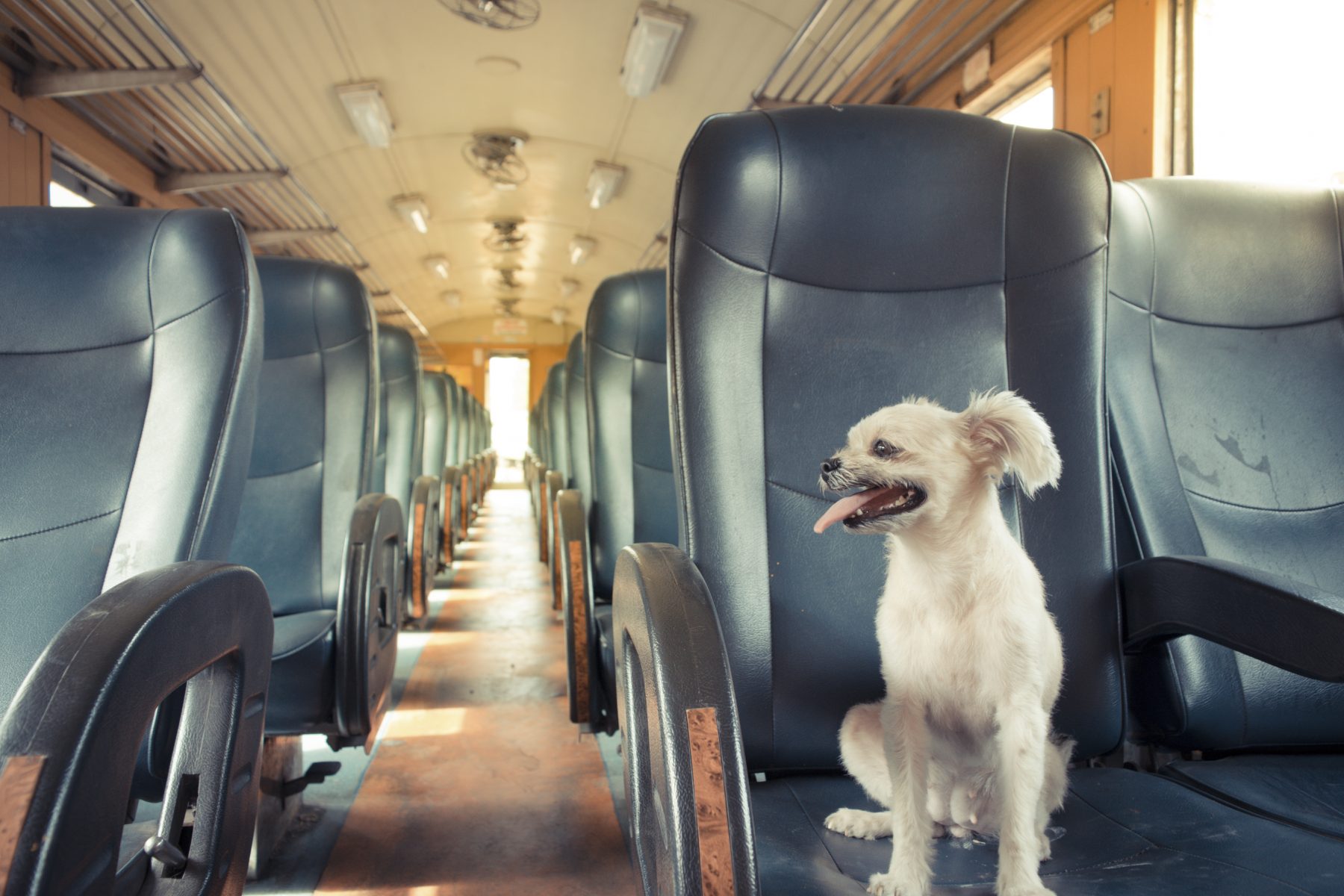
I’ll go over what you should have with you if you are traveling with your pet by train, as well as summarize the rules and policies for some of the rail transit systems in the US!
Why Travel by Train With Pets?
Traveling by train can be much safer than flying. That’s because air travel can put your pet at risk due to changes in air quality, air circulation, temperature, cabin pressure, and other environmental issues that could be harmful to your pet’s health!
In fact, select short-nosed breeds are not allowed to travel on certain airlines because of respiratory issues that may make it especially difficult for them to breathe properly under the stress and environment of flying.
If you’re a dog owner and you have one of the following breeds, it may be especially important for them to avoid air travel:
- French Bulldog
- Japanese Chin
- Neapolitan Mastiff
- Brussels Griffon
- Bullmastiff
- Affenpinscher
- English Toy Spaniel

What Trains Can I Use to Travel With My Pet?
There are a number of different train systems in the US you can take to travel with your pet. Here are some common train systems in the US you may consider looking into if you are thinking about traveling by train.
- Alaska – Alaska Railroad
- Arizona – Valley Metro Rail, Sun Link
- Arkansas – Metro Street Car
- California – Altamont Corridor Express, Bay Area Rapid Transit, Caltrain, Coaster, Light Rail, Metro Rail, Metrolink, Muni Metro
- Colorado – RTD Rail
- Connecticut – Shore Line East
- District of Columbia – DC Street Car, Metrorail
- Florida – Metromover, Metrorail, Tri-Rail
- Georgia – MARTA Rail System
- Illinois – Metra
- Maryland – MARC
- Massachusetts – CapeFLYER, MBTA Commuter Rail
- Michigan – Detroit People Mover, QLine
- Minnesota – METRO
- Missouri – Metrolink
- Nationwide – Amtrak
- New Jersey – Hudson-Bergen Light Rail
- New Mexico – New Mexico Rail Runner Express
- New York – Long Island Rail Road, Metrorail
- Oregon – WES Commuter Rail
- Pennsylvania – Norristown High Speed Line, PATCO Speedline
- Texas – A-Train, Capital Metro Rail
- Utah – TRAX
- Washington – Link Light Rail
What You Should Have With You
Fortunately, traveling by train with your pet is much easier than flying. That’s because in the vast majority of cases, you won’t have to worry about having to produce proof of vaccinations, a health certificate, or any other type of paperwork. In fact, most of them only require that your pet be able to travel in a pet carrier that can fit on your lap, or underneath your seat.
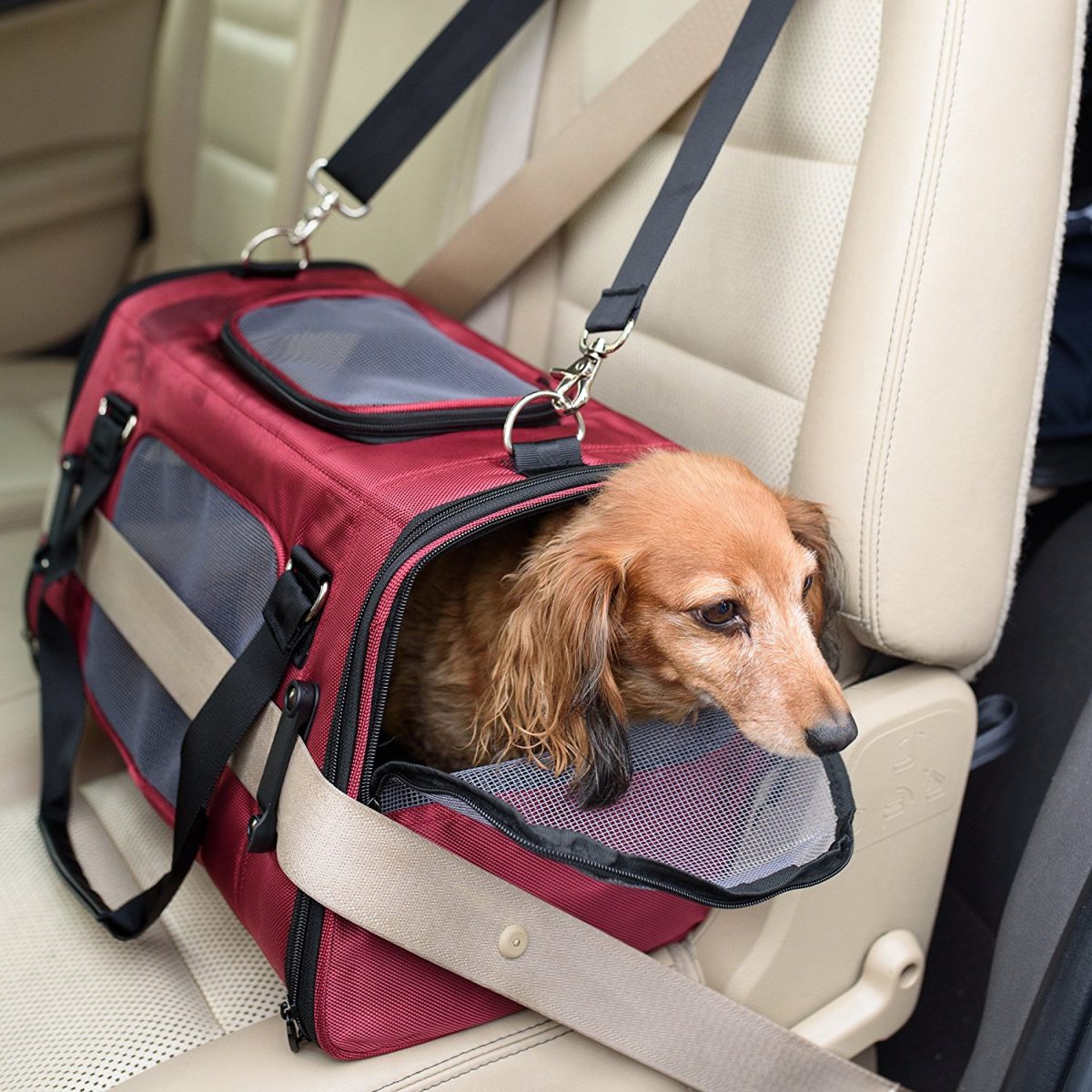
If you will be traveling with a service dog, some train stations will require they wear some sort of identifying vest or special identification to indicate they are a service animal. Otherwise, you should have no problems finding a train system to allow you to travel with your service animal.
Here is a more detailed list of some of the train systems and their specific policies!
Getting Rewarded for Your Train Travel
If you decide to travel by train with your pet, or need to buy supplies in preparation for your trip, remember to use the best travel credit card to earn valuable miles and points for your future travels! Here are some of our favorites:
- Chase Sapphire Reserve® – You’ll earn 3X Chase Ultimate Rewards points per $1 spent on travel (excluding $300 travel credit) and dining. And because Chase’s definition of travel also includes purchases made with operators of passenger trains, this is a great card to purchase your train tickets with!
- Ink Business Unlimited℠ Credit Card – Earn 1.5% cash back (1.5X Chase Ultimate Rewards points) on all purchases . Handy for if you need to buy a new pet carrier!
- Capital One® Venture® Rewards Credit Card – Earn 2 Venture miles per $1 you spend on all purchases, perfect if you are looking for a card with simple rewards!
Bottom Line
There are a number of rail transit systems available in the US if you are looking to travel by train, and many allow you to travel with your pet with very little restrictions and hardly any documentation requirements. In fact, when it comes to service animals, many train systems only require they be properly identified with a vest or harness.
If flying with your pet is not an option, traveling by train can be a great alternative. It can often be safer, cheaper, and less complicated. That’s because the stress and environment of flying can be harmful to your pet’s health! Traveling by train does not subject them to the potentially traumatic pressures of flying, and can be a great way to travel with your pet without having to leave them at home!
Contributor
Andrew Wan is a contributor for Million Mile Secrets where he covers points, miles, credit cards, airlines and hotels. His work has also appeared in The Simple Dollar.
More Topics
General Travel
Join the Discussion!
Comments are closed.
You May Also Like

BonusTracker: Best credit card bonus offers
June 14, 2021 4

Best Hilton credit cards: Improved weekend night certificates, earning rates and more
June 12, 2021 2
Our Favorite Partner Cards
Popular posts.

A Guide to Travelling with Pets on Indian Railways

Table of Contents
Indian Railways allows passengers to bring their pets on board, but there are certain rules and regulations that must be followed. Travelling with pets on Indian railways requires careful planning and adherence to specific guidelines to ensure the safety and comfort of both your pet and fellow passengers. Here, we will explore the essential aspects of travelling with pets on Indian railways, including ticketing, documentation, pet carriers, and more.
Understanding the Pet Policy
Before embarking on your train journey, it’s crucial to familiarize yourself with Indian Railways’ pet policy. The policy outlines the rules and regulations for travelling with pets, ensuring a smooth and harmonious travel experience for everyone involved. Here are some key points to keep in mind:
- Pets can travel on Indian railways, but there are certain conditions and restrictions.
- Only dogs, cats, and birds are permitted as pets on trains.
- Pets are only allowed to travel in AC first-class and first-class compartments.
- Each passenger is allowed to carry a maximum of two pet dogs, cats, or birds.
- The pets must be clean, healthy, and free from diseases.
- They should be properly vaccinated and have a valid vaccination certificate.
- Pets are not allowed to travel in AC2 tier, AC3 tier, AC Chair Car, Sleeper Class, and Second Class compartments.
- Pets must wear a muzzle and be on a leash whenever they are outside of their basket or crate.
- Pets are not permitted to occupy seats or berths.
- Pets must be carried in a basket or crate that is large enough for them to stand up and turn around in.
- You will be held responsible for any damage caused by your pet, including any damage to the train or other passengers’ belongings.

Booking Train Tickets for Your Pet
To ensure a hassle-free journey, it’s important to book tickets for your pet in advance. Here’s what you need to know about pet ticketing on Indian railways:
- Pet tickets can be booked along with the passenger’s ticket.
- The fare for a pet ticket is generally 30% of the second-class luggage rate.
- It is advisable to book your pet’s ticket at the same time you make your reservation to secure a spot.
To book a pet for travel on Indian Railways, you need to contact the parcel office at the railway station where you will be boarding the train. You will need to provide the following information:
- The name, breed, and weight of your pet.
- The destination of your journey.
- You will also need to pay the applicable charges.
Documentation Requirements
Proper documentation is vital when travelling with pets on Indian railways. To avoid any last-minute complications, make sure you have the following documents ready:
- A valid vaccination certificate from a registered veterinarian.
- Identification tags or microchips for your pets.
- A health certificate issued by a veterinary doctor clearly certifying that your pet is fit to travel.
Choosing the Right Pet Carrier
Selecting the appropriate pet carrier is crucial to ensure the comfort and safety of your furry companion during the train journey. Consider the following factors when choosing a pet carrier:
- Opt for a sturdy carrier that is well-ventilated.
- Ensure the carrier is spacious enough for your pet to stand, sit, and turn around comfortably.
- The carrier should have a secure latch or lock mechanism to prevent any accidental openings.
Preparing Your Pet for the Journey
Preparing your pet for the train journey is essential to minimize stress and ensure their well-being. Here are a few tips to help you prepare your pet:
- Familiarize your pet with the carrier before the journey by allowing them to explore and spend time inside it.
- Take your pet for a short practice trip in the carrier to acclimate them to the sensation of being transported.
- Pack essential items such as food, water, medications, and comfort items to keep your pet comfortable during the journey.
The charges for travelling with a pet on Indian Railways are as follows:
AC first class: Rs. 60 per kilogram per pet.
First-class: Rs. 30 per kilogram per pet.
For small pets (puppies and kittens)
If you are carrying puppies or kittens, they can be kept in baskets in all classes, but they must be muzzled and on a leash at all times. The charges for carrying puppies and kittens are as follows:
All classes: Rs. 20 per kilogram per pet.
Here are some tips to ensure a smooth journey with your pet on Indian Railways
- Make sure your pet is well-behaved and comfortable in their basket or crate.
- Bring enough food and water for your pet during the journey.
- Take your pet for a walk before the train departs.
- Be prepared to answer questions from fellow passengers about your pet.
- Be patient and understanding if your pet feels stressed or anxious during the journey.
By following these rules and tips, you can ensure that your pet has a safe and enjoyable journey on Indian Railways.
- Indian Rail Info
Can I travel with any type of pet on Indian railways?
Only dogs, cats, and birds are permitted as pets on Indian railways. Other types of pets may not be allowed.
Do I need to inform the railway authorities in advance about travelling with my pet?
It is not mandatory to inform the railway authorities in advance about travelling with a pet. However, it is advisable to mention it while booking your own ticket to ensure a hassle-free journey.
Are there designated areas for pet owners on Indian trains?
Indian railways do not have designated areas for pet owners. However, it is advisable to choose a seat or berth that is closer to the entrance to facilitate easier movement when taking your pet out for restroom breaks.

Dr. Tamal Dey
I am a pet expert dealing with Cats, Dogs, Birds, Rabbits and Aquarium fish for the last 10 years. Now it is time to share my knowledge with you. I am very passionate about sharing everything that I learned so far about pet care. Watch my Youtube channel Petfather
- Dr. Tamal Dey https://www.petfather.in/author/tamald40/ Doberman Dog Price in India, Lifespan and Breed Profile
- Dr. Tamal Dey https://www.petfather.in/author/tamald40/ How Old is My Bird Actually? Bird Age Calculator
- Dr. Tamal Dey https://www.petfather.in/author/tamald40/ Alsatian or German Shepherd Dog Price in India, Lifespan and Breed Profile
- Dr. Tamal Dey https://www.petfather.in/author/tamald40/ Diwali Pet Care: If You Are a Pet Owner Then Watch Out!
Related posts:
- Virat Kohli’s Pets: King Kohli and His Love For Dogs
- Finding the Right Litter Box for Cats
- Scottish Fold Price in India, Lifespan and Profile
- Persian Cat Price in India, Lifespan and Profile
- Munchkin Cat Price in India, Lifespan and Profile
- Legal Pets in India (and Which Pets are Banned in India?)
- Dogs Price in India | Most Popular Dog Breeds in India
French Bulldog Dethrones Labrador Retriever as America’s Most Popular Dog Breed
Pet Ownership Linked to Lower Stress and Loneliness During COVID-19 Pandemic
2 thoughts on “A Guide to Travelling with Pets on Indian Railways”
- Pingback: Dogs Price In India | Most Popular Dog Breeds In India (March 2024)
- Pingback: Celebrating Petfather's 100th Post: 100 Pet Care Tips For Pet Owners By Petfather
Leave a Comment Cancel reply
You must be logged in to post a comment.
Questions about traveling with a pet?
Contact | email | facebook, european pet travel by train.

Pet Friendly Trains in Europe
Your pet can travel with you on most trains in Europe including Rail Europe (except trains in Spain, Ireland, Great Britain, Finland and Norway) and RailJet. Only service dogs traveling with visually impared passengers are permitted on Eurostar trains.
Dogs, cats and ferrets traveling by train across country borders must have a minimum of one current rabies vaccination administered after a microchip is implanted and no sooner than 21 days prior to travel. If your pet has had more than one rabies vaccination given after the chip was implanted and all were kept current, you do not need to wait for 21 days after the booster. Dogs, cats and ferrets must travel with an EU Pet Passport issued by your veteriarian.
Guide dogs traveling with visually impared or disabled passengers can travel for free on European trains.
Here are the pet policies of trains that will carry your pet running in Europe:
- Virgin Trains welcomes two dogs, cats or other small domestic animals with every customer on the east and west coast routes between London and Scotland at no extra cost.
- TGY Lyria - Pets weighing less than 6kg can travel in carriers or baskets measuring less than 45x 30 x 25cm without charge. Maximum of 2 pets per passenger. Pets weighing more than 6kg must pay a pet fare and wear a muzzle. Pets must remain on the ground by their passengers.
- Thello - Pets weighing less than 5kg travel for free with no reservation required. One pet per passenger and pet must travel in a carrier, basket or cage. Pets may be moved by conductor if other passengers object. Pets over 5kg must travel with a passenger in a cabin occupied by the passenger and/or their family. Pets must remain in the cabin and not left alone. Owners are responsible for any and all damage done by their pet.
- Thalys - small dogs and domestic animals may travel free in a carrier measuring less than 55 x 30 x 30cm. Pets must not disturb other passengers and may be asked to move if that is the case. Larger dogs must be leashed and muzzled and will pay a dog fare ticket. note that no pets are permitted on the Neige and Soleil trains. Service animals only on routes serving London.
- Deutche Bahn - pets are welcome on this train. If they cannot fit in a carrier, they will pay half fare to travel. Dogs small enough to travel in carriers can do so without charge unless they are crossing borders. In this case, all pets are subject to a half-fare ticket. Pets not in carriers must be leashed and muzzled at all times.
- Renfe - dogs, cats, ferrets and birds (not chickens) are welcome on Renfe trains. One pet per passenger not weighing over 10 kg are permitted as long as they travel in a container smaller than 60 x 35 x 35cm. For overnight travel, passenger must book a department or family cabin. Pet owners are resonsible for any and all damage caused by their pet. Renfe has extended a special program allowing pets up to 40 kg on their trains that run between Madrid and Barcelona and has now extended it to Malaga. Larger dogs must travel no closer than 2 seats apart and only 2 large dogs are permitted in a single car. Pet owners should plan to check in at least 40 minutes in advance of departure. One pet is permitted per person. More details here .
- SNCF (National society of French railways) - Book your pet's reservation when you book your own. Tickets subject to cancellation fee. Dogs, cats, pet rabbits and rodents, birds, reptiles and amphibians under 6kg must travel in a carrier measuring less than 45 x30 x 25cm. The fare for small pets is 7€ on TGV, intercity and TER trains. If your pet weighs more than 6kg, it must be muzzled all times. The fare will be 50% of the full 2nd class fare on TGV, intercity and TER trains. Pets are not permitted on trains to or from the UK.
- OBB - well behaved pets are welcome. Smaller pets can travel free, but must travel in a secure carrier or container. Larger pets will incur a fare and must be leashed and muzzled.
- In Italy, Trenitalia trains permit dogs in first and second class cars, both small and large. Pets are not allowed in the restaurant or bar cars, except for servoce dpgs, who travel for free on all trains.
England: Pets are accepted on trains operated by National Rail. Dogs and cats with owners can travel by train in the UK with no seating restrictions and usually free of charge. Two pets are permitted per person without charge as long as they are leashed. Dogs and cats can also travel on buses, subject to a fare being paid, but with no seating restrictions. For other lines in the United Kingdom, check with the railway as some do not allow pets. For information on the trains operated by National Rail, scroll to the bottom of the page.
Non-dangerous and non-offensive pets are allowed on Transport for London (TfL) bus and underground services free of charge. Pets must be leashed or contained in a carrier and are not allowed on passenger seats. Owners must keep their pets under their control at all times. They must be carried when on escalators (unless trained to ride on escalators), when an elevator is not available.
In most cases, small dogs travel free or at a minimal charge, and large dogs travel at half the 2nd class fare, even if traveling with passengers in 1st class; this charge is payable directly to the conductor.
Oftentimes, dogs are required to be kept in a traveling container or must wear a muzzle and a leash. Dogs in a carrier may travel at a minimal cost, depending on the country. A small domestic animal in a carrier can travel free of charge. Dogs accompanied disabled passengers travel free of charge.
Dogs are allowed on trains as long as the other passengers sharing the car/compartment agree to it. A dog is allowed in a sleeper car only if it is fully occupied by the owner (i.e. two passengers with a dog in a double).
Dogs/other animals are not allowed on all trains in Great Britain, Ireland, or Norway but are allowed on many of the local trains. No pet or animal, except guide dogs, may be taken on the Eurostar. Pets are allowed to travel in automobiles across the Chunnel on Le Shuttle from Calais, France to England. Limit of 5 pets per vehicle. You should always double check all rules locally.
Dogs of all sizes (muzzled and leashed) are accepted on Trenatilia operating in Italy. Small dogs can ride for free in first and second class. Avoid traveling between 7:00AM and 9:00AM on weekdays on regional trains. More details riding a train in Italy with a pet .
In Rome, dogs can ride the Metro in the first and last carriage cars. Dogs must be in a carrier or muzzled and leashed. A ticket must be purchased for your pet. More details on riding the Metro in Rome with a pet .
In Finland, as in most countries, you will need to purchase a special ticket for your pet. See http://www.vr.fi/heo/eng/palvelut/palvelut.htm for details.
To purchase your travel documents, or for further information you can visit the Rail Europe web site at www.raileurope.com .
National Railway Train Pet Travel - United Kingdom Passengers may take dogs, cats and other small animals (maximum two per passenger) with them, free of charge and subject to conditions below, provided they do not endanger or inconvenience passengers or staff.
Dogs must be kept on a lead at all times unless contained in a carrier. Dogs without leads, cats, birds and small animals must be carried in an enclosed basket, cage or pet carrier measuring not more than 85 x 60 x 60 cm. It must be rigid and not open (to prevent escape) and the animal able to stand and lie down in comfort.
Animals and containers must not occupy seats, otherwise a charge will be made.
Animals are not allowed in restaurant cars except for blind persons' guide dogs or deaf persons' assistance dogs, which may be allowed into the restaurant car at the Steward's discretion. However, every effort is made to serve meals at blind or deaf persons' seats within the normal seated accommodation.
Guide dogs assisting blind or deaf persons are allowed on sleeper services provided the blind or deaf person and dog are booked into single-cabin accommodation. The guide or assistance dog is conveyed free and no cleaning charge applied.
ScotRail allows dogs to accompany able-bodied passengers in sleeper services subject to a charge for a heavy duty clean, and the booking must be either Standard Class with two people traveling together, otherwise a Solo supplement is payable for exclusive use of a twin-berth cabin. Booking for all dogs traveling in sleepers should be made at least 48 hours in advance.
By-law 16 allows the train company to refuse carriage or entry to any animal. If a customer objects to the presence of an animal, the owner must move it to another part of the train or put it in a suitable container in the guard's van/luggage van where available. When dogs are carried in the guard's van/luggage van (other than those in a container) they must be secured with collar and chain and properly muzzled.
More information at http://www.nationalrail.co.uk/passenger_services/luggage_animals.html
Need More Information?

If you have questions, you can post them directly to our Facebook page , blog , forum . We will answer them as soon as we can.

Traveling Amtrak For The First Time? Here Are 14 Things To Know About Amtrak Trains
F eel the need to go outside New York City? Confused about which ride to select? Forget going to out-of-the-way airports or using crowded taxi services. The Amtrak train offers the ultimate solution to meet everyone's travel needs. Meet the luxurious train that makes passengers feel like they're at home. The endless amenities and friendly, respectful staff also make one's trip memorable.
Many Amtrak trains successfully run across hundreds of tracks in the United States (most Amtrak trains offer incredibly beautiful routes , too), and there's also a rich history behind the company. Multiple packages are available for every type of passenger, depending on budget, accommodation choice, and other factors. For a pleasant change, the Amtrak company charges no extra fees, i.e., passengers get what they see, unlike some airliners who keep adding extra surcharges to a customer's expense list till the last moment.
Related: Empire Builder: What Makes This Amtrak Route One Of The Most Scenic In The U.S.
Furthermore, passengers get extra legroom for a long journey compared to a car or air travel. The Amtrak also saves on fuel and protects one's personal vehicle from wear and tear if one uses it to travel. So, with that in mind, let's skim through some important things travelers should know about the trains, such as Amtrak train routes and prices, etc.
UPDATE: 2023/06/06 21:47 EST BY REENA JAIN
More Things To Know About Amtrak Trains For First Time Travelers
Everyone should be aware of a few things before embarking on their first Amtrak journey, regardless of the destination or length of the journey. This list has been updated with additional important information, including train routes, prices, schedules, destinations, and more to help travelers have a stress-free, relaxing, and enjoyable Amtrak journey.
The Amtrak App
The Amtrak app makes it simple for travelers to plan and reserve their trips, check Amtrak schedules and destinations, and receive real-time alerts for delays or changes. Users can access their e-tickets through the app, which provides information on Amtrak train routes and prices. Additionally, the app includes interactive maps that help passengers track the whereabouts of the train and get knowledge of the schedule. The Amtrak app has a user-friendly interface and convenient features, making train travel more simple, reliable, and enjoyable.
Expect Train Delays
Amtrak trains need to stop at some places to let large freight trains pass because they share the same tracks. It can result in unforeseen delays in travel times, especially on longer, cross-country routes. For instance, the California Zephyr from Chicago to Denver may need to stop before the Moffat Tunnel to allow a freight train to pass, delaying Amtrak schedules. Therefore, researching Amtrak schedules and destinations is beneficial before making travel plans.
Making A Pre-Departure Checklist Is Helpful
Passengers will require a number of items, including those necessary and desirable for a stress-free and memorable Amtrak trip. Some of these—like an ID—are necessary, while others are worthwhile for an enjoyable Amtrak journey.
Identification
Passengers must have a photo ID or passport with them.
Train Tickets
Passengers should have hard copies of their tickets or electronic copies of their tickets on hand.
Travel insurance
It's essential to protect oneself from unanticipated travel mishaps.
Passengers who will need to take any medication while traveling must bring it with them.
Other Essentials
Personal care items, snacks, beverages, books, and some forms of entertainment are desirable (but not necessary) for a comfortable trip, particularly on long Amtrak routes.
Stations Have Different Stopover Times
The train makes scheduled stops at various stations during a trip, and the stopover time varies depending on the type of station. If a station is a rest stop, the stopover time is comparatively longer than that of a passenger drop-off and pick-up location. Knowing if a specific stop is a designated rest stop where passengers are permitted to disembark is preferable for those who want to smoke because smoking is not permitted on the train or simply want to move around the station.
Reasonable Ticket Prices
Amtrak tickets are reasonably priced! The average price of a ticket from New York to Atlantic City is about $94 (although Amtrak's famous roomettes typically cost much more ). It is pretty budget-friendly compared to any airline fare on the same route, and it is not even the lowest price out there. The cheapest tickets on this Amtrak route can even be found for only $82.
The best thing is to avoid rush hour and book your Amtrak tickets well in advance. Plus, a cool tip: Amtrak offers saver fares on each route, where passengers can save up to 20% compared to the standard Coach fare when booked at least 7 days in advance. Furthermore, Amtrak fares for seniors (aged 65 and up) are 10% less than the standard fare on most trains in the United States, and seniors (aged 60 and up) pay 10% less for cross-border services operated by Amtrak and VIA Rail Canada.
Plenty Dining Choices
Amtrak offers many dining choices to its customers. There is something tasty and appetizing for every passenger, from adults to kids. Some of these main options include:
Passengers can access the café, which is open to passengers from all classes of the train from the early morning until late at night. Whether business or economy class, there are snacks, drinks, and food items for everyone.
- Traditional Dining
Traditional dining service for passengers in private rooms is provided in the dining car as a complimentary exclusive offering.
- Flexible Dining
Exclusive offer to First Class passengers to eat at flexible timings. Special diet menus are also available at Amtrak for customers with specific dietary requirements. The food menu comes with a detailed calorie breakdown as well.
A Variety Of Accommodations
The Amtrak from New York to Atlantic City offers various services and accommodations. Among the expert tips for first-time Amtrak passengers is to check the various room options available in order to best fit the needs and budget of a passenger.
- Seating Options
Even the Coach class has the best comfy seats. Imagine reclining sofa-like seats with spacious areas. The addition of multiple amenities combines to make the trip a relaxing one! For passengers with mobility impairments, Amtrak provides accessible seating arrangements.
- Private Rooms
Amtrak provides a unique luxurious experience to its passengers by offering private rooms to First Class. If one wants privacy and their own space on a short trip with added comfort, then a private room booking is the perfect step.
Related: California Zephyr Vs. Southwest Chief: Which Amtrak Train Route Is More Scenic?
Wi-Fi On Board
The Amtrak train comes with complimentary Wi-Fi during traveling. The speed of Amtrak Wi-Fi is less than a passenger’s home or work Wi-Fi network. Furthermore, the same Wi-Fi gets shared by all the passengers on the Amtrak from New York to Atlantic City. So, each passenger should try to surf the internet in such a limited way as not to overburden the network for the other onboard users.
The key is not downloading large files or streaming heavy videos online and keeping fellow passengers in mind while using the shared Wi-Fi. That is why limited access is provided by Amtrak so that more onboard bandwidth is available to all passengers. Access to websites with objectionable content is also restricted in this shared onboard Wi-Fi.
Onboard Upgrades
The trains are divided into classes: Coach, Business, and First Class. All these classes differ from each other, with a different set of rates and amenities for each of them. So, if space is available as unoccupied in a class, one can upgrade from one's original class to that higher class seating. It can be from Coach to Business or Business to First Class.
This smart feature can change the outlook of one's whole journey. Passengers only need to speak to the conductor onboard. They might inform about the availability of such an upgrade and let passengers purchase a new class seat.
Passengers Can Bring A Bicycle Along
Amtrak offers its customers the opportunity to bring their bicycles along. One can explore the stops along the way during a train journey - and what better way to do that than by bike? Ride the rails on board the train with a bike - sounds awesome! Amtrak offers several different services to transport a customer’s bike onboard.
Remember, though, that each train has different equipment and loading procedures that decide what service will be offered. The starting and ending destination stations also determine how or what is allowed by Amtrak regarding one's bicycle. For carry-on/train side, bicycles up to 50 lbs are allowed. Here, standard bicycle sizes apply with a maximum tire width of 2 inches.
Enjoy Guest Rewards
Amtrak offers a guest rewards system to its customers . The points earned can be used to travel on trains, stay at hotels, and shop.
- Earning Points
Customers can earn guest rewards by earning points through various means, both on and off the train. Passengers can earn 2 points for every $1 spent.
- Redeeming the Points
Customer of Amtrak can easily redeem their earned points. The reward travel begins at just 800 points, with train travel allowed to over 500 destinations.
- Member Benefits
Becoming an Amtrak member rewards customers for every ride on and off the train.
- Bonus Points
One can earn 20,000 bonus points with the new Amtrak Guest Rewards® Preferred Mastercard®. Customers can even choose from over 350,000 hotels worldwide to stay at using their collected points.
Passengers Can Bring Pets
Pets are allowed to travel on Amtrak. However, like with air travel, there are restrictions. Dogs and cats can come on trips that can take up to seven hours on most Amtrak routes in a pet carrier - of course, for a small fee. The pet carrier must also be spacious and highly ventilated, allowing for free movement of the animal, and the weight of the pet and carrier combined must be under 20 lbs.
Things to Note About Pets on Amtrak Trains
- Service animals are readily welcomed on all Amtrak services as they are not included in the pet category.
- Pets are not allowed to travel as baggage. A pet must travel with its human counterpart on a train.
- Only dogs and cats are allowed to travel as pets on Amtrak, and pets must be at least eight weeks old and up to date on all vaccinations.
- Amtrak highly recommends making pet reservations in advance of one's trip.
Related: Roomette Vs. Sleeper Bedroom: Knowing The Difference On An Amtrak
Baggage Limits
With Amtrak, customers can shed their baggage worries as the company handles everything meticulously. As baggage, a customer may bring 2 carry-on items. Here, limitations apply regarding weight and size. So, browse them beforehand. Checking this guide on what to pack for an Amtrak train ride may also be handy in terms of prioritizing what to bring (and what not to bring to save baggage weight and space).
Similarly, for checked luggage, each traveler can bring 4 bags, 2 are registered as free, and the other 2 are at $20 per bag. Again, size/weight limitations apply. For special items of baggage that require special handling or are outside the normal baggage category, Amtrak may ask for additional packing requirements and service fees. Amtrak also prohibits certain items onboard trains for security purposes.
Going with unreserved seating on a packed train? No worries. Travelers can find a Red Cap (baggage porter) to escort them to the train. They can access the track before the masses and carry their bags. Red Cap services are free, but a generous tip is recommended.
No Security Line No Waiting
Amtrak lets passengers simply go to the track and get on the train. There is no security line blockage as there is at the airport. With a reduction in airport TSA staff and more passengers flying, travelers need to get to the airport about two hours before their flight just to have enough time to check in or check a bag and clear security.
With Amtrak travel, one's ticket might be scanned before entering the platform or scanned onboard, but there is no waiting line. On the other hand, Amtrak recommends arriving 30 minutes before one's train departs.
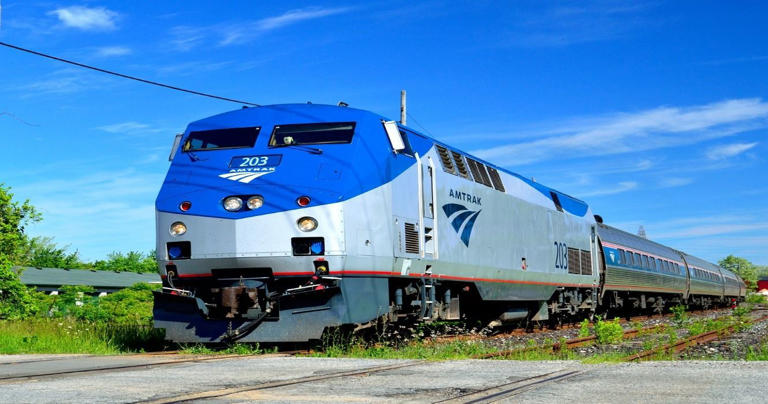
- Cat Behavior
- Health & Care
How to Travel With a Cat: 14 Vet Approved Tips & Tricks
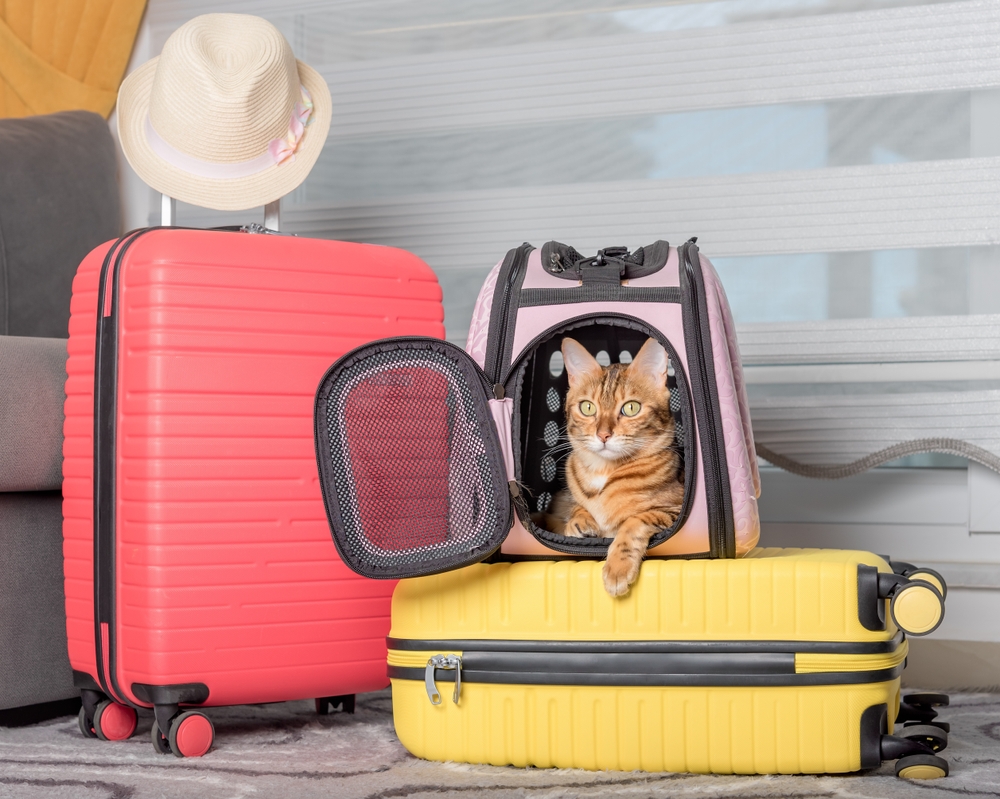
Image Credit: Svetlana Rey, Shutterstock
Last Updated on April 19, 2024 by Catster Editorial Team
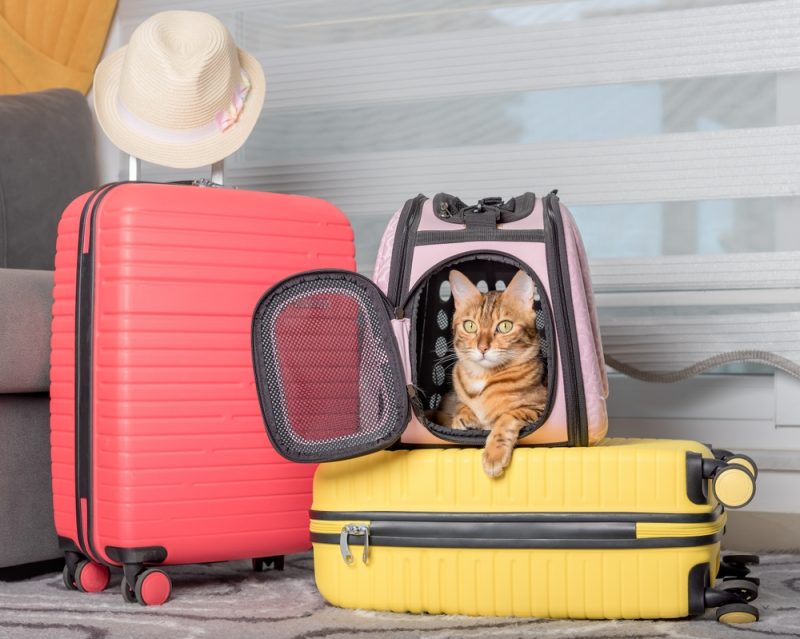
VET APPROVED
REVIEWED & FACT-CHECKED BY
Dr. Amanda Charles
BVSc GPCert (Derm) MRCVS (Veterinarian)
The information is current and up-to-date in accordance with the latest veterinarian research.
Traveling with a cat can be rewarding, but it requires thorough planning. Whether you’re getting ready to drive a short distance and hang out with family or fly somewhere for a relaxing vacation, there are a few factors to consider when traveling with your cat.
Make sure to start the planning process early, particularly if you’re traveling internationally or are going to stay in a hotel during any part of your journey. Below, you’ll find 14 tips and tricks to make your journey with your cat successful.

- The 14 Tips to Travel with a Cat
- 1. Invest in a Good Carrier
Cats should always be restrained when riding in cars, and airports require them to stay in their carriers at all times (except during the security screening process). Airlines have several rules and regulations regarding traveling with pets, including guidelines regarding the size of carriers.
Make sure the carrier you use meets the airline’s regulations and requirements. If you’re driving, the sky’s the limit when it comes to the size of your cat’s mobile palace. Carriers should be sturdy, well-ventilated, secure, and easy to clean. Plastic carriers are usually the best options.
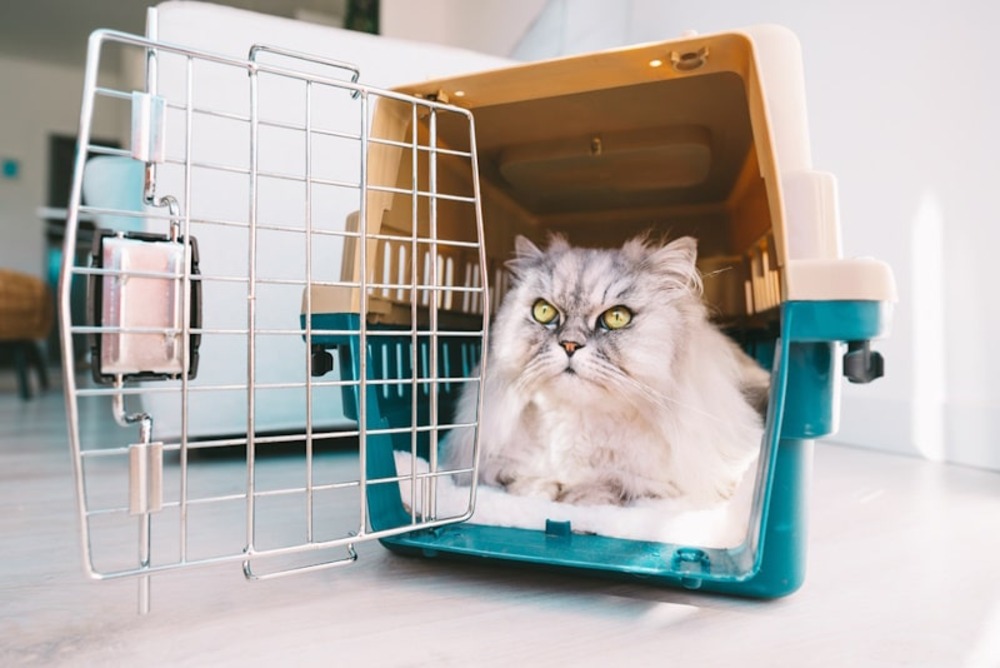
- 2. Give Your Cat Time to Get Used to Their Carrier
Because cats spend so much time in their carriers when traveling, they must feel comfortable in them. Consider leaving your cat’s carrier out so they can get used to it before your trip.
Letting your cat have dinner in their carrier a few times may encourage them to develop positive associations with their traveling home.
- 3. Invest in a Good Harness and Leash
If you visit a rest stop during a road trip, your cat should be harnessed and leashed when they’re away from their carrier to ensure they can’t run off and get lost if they become scared.
Make sure the harness you choose fits properly, and give your cat time to get used to wearing it so they’re ready to do so when you hit the road.
Are you looking for the perfect cat harness? We suggest Hepper's Cat Harness & Leash Set , which includes a nicely designed, machine-washable harness made from soft, sturdy velvet and mesh.

- Escape Proof - Cat leashes and harnesses for walking aren't all equally secure. Our double aluminium...
- Superior Comfort - Our cat harnesses are lightweight, made with premium velvet fabric, breathable...
- Free Extra Strength Leash - You don't need to worry about your cat escaping this harness. This cat...
This harness is easy to put on and take off and features reinforced stitching, reflective stripes, and quick-release buckles. This set also includes a great leash made from durable nylon climbing rope.
At Catster, we’ve admired Hepper for many years and decided to take a controlling ownership interest so that we could benefit from the outstanding designs of this cool cat company!
- 4. Practice Everything
No matter how you’re traveling, your cat must be comfortable entering and exiting the carrier. If you’re flying, you’ll need to take them out of their carrier during the security screening process in the airport.
You can practice taking your cat out of the carrier when you’re around other people to make them more comfortable during the security check. If you plan on driving, consider taking your cat for a few practice rides to get them used to spending time in the car. Make sure to reward them for their cooperation!
- 5. Ask Your Veterinarian for Advice
Some easily stressed cats may benefit from medication to help them stay mellow while traveling. However, sedation isn’t suitable for all cats, and most airlines won’t transport pets who have been tranquilized or sedated.
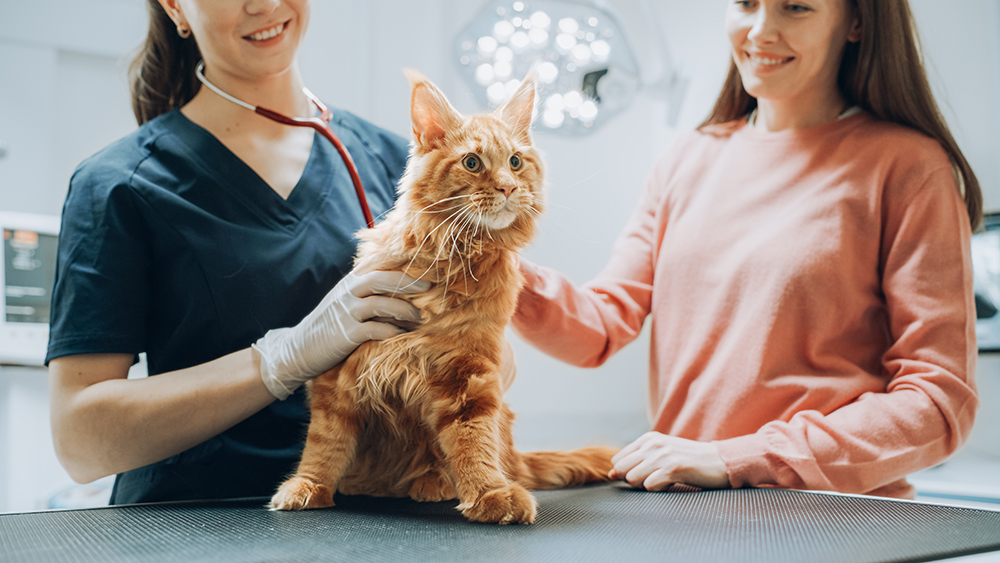
- 6. Have Cleaning Supplies on Hand
Pack a bag with cleaning supplies and plan to have it close at hand while you’re underway in case your cat has an accident and you need to do a bit of on-the-fly cleaning. It’s best to pack paper towels or cleaning wipes, gloves, and baggies for disposal.

- Gentle Care For All Pets - Infused with moisturizing hypoallergenic ingredients & enriched with...
- Deep Cleans From Head to Tail - Tackle the toughest dirt & messes with our extra strong pet wipes...
- Freshness On The Go - Each dog grooming wipes pack contains 30 counts of premium dog wipes that...
It's hard to beat the convenience of pet-safe wipes after a big adventure, between baths, or when cleaning sensitive areas. Our favorite option is Hepper's Wash Wipes, premium wipes designed to safely and gently remove grime from cats and dogs of all ages and sizes. These hypoallergenic wipes are made in the USA and feature moisturizing ingredients to soothe your pet's skin.
- 7. Pack Toys and Blankets
Take a few of your cat’s favorite toys and a well-loved blanket that smells like home to keep them comfortable while away from their territory. Putting a favorite blanket in your cat’s carrier may make being on the road less stressful.
A stuffed toy might look a little different than a traditional cat toy but many felines find them quite enticing. The Hepper Plush Whale serves a dual purpose, featuring a faux fur exterior that mimics prey and a soft interior for cuddling during long cat naps when playtime is over. The best part about it is it's an affordable option for ages, sizes, and conditions. Learn more about why your cat needs a plush here!

- Tailored size even for kittens - the compact size of the whale plush cat toy at 15cm long ensures...
- Catnip Free Cat Toys - Made with top quality plush exterior & cotton interior, it's perfect for cats...
- Peaceful Playtime - No more squeaky cat toys for indoor cats. This stuffed cat toy is perfect for...
At Catster, we've admired Hepper for many years, and decided to take a controlling ownership interest so that we could benefit from the outstanding designs of this cool cat company!
- 8. Consider Portable Litter Boxes
If you’re traveling by car , pack a litter box with some of your cat’s regular litter. Plastic poop bags and a scoop are also essential. If you’re staying at a hotel, check their pet policies thoroughly.
Most hotels that accept cats don’t provide litter boxes and litter. Collapsible litter boxes are ideal for shorter trips and can be folded down and packed.
- 9. Pack Food, Water, Treats, and Medication
If you’re traveling by car, bring enough of your cat’s regular food to keep them happy while you’re away from home. It’s also helpful (and usually mandatory) to pack food and water for your cat while flying, but some cats may be too nervous to eat until you land.
If your cat takes medication, pack enough to last them for your entire trip, and consider putting it in your carry-on luggage to ensure you have access to it even if your checked luggage takes a detour.
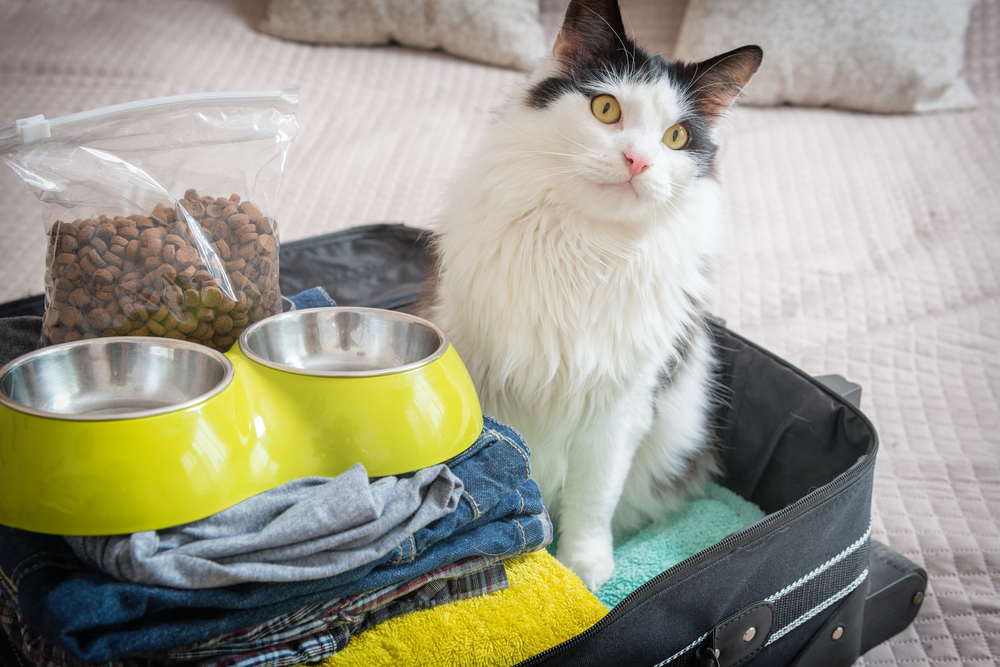
- 10. Consider Pheromones
Commercial synthetic feline pheromone products may help some cats stay calm while underway by reducing stress and creating a sense of safety and well-being. They’re available in sprays and wipes, so your cat can enjoy the benefits of calming pheromones while you’re on the road.
- 11. Check Your Cat’s Microchip Registration
Ensure that the registry where your cat’s microchip is registered has the right contact information. Losing your cat when you’re out of town is a nightmare, but an up-to-date microchip can significantly improve the chances of their return.
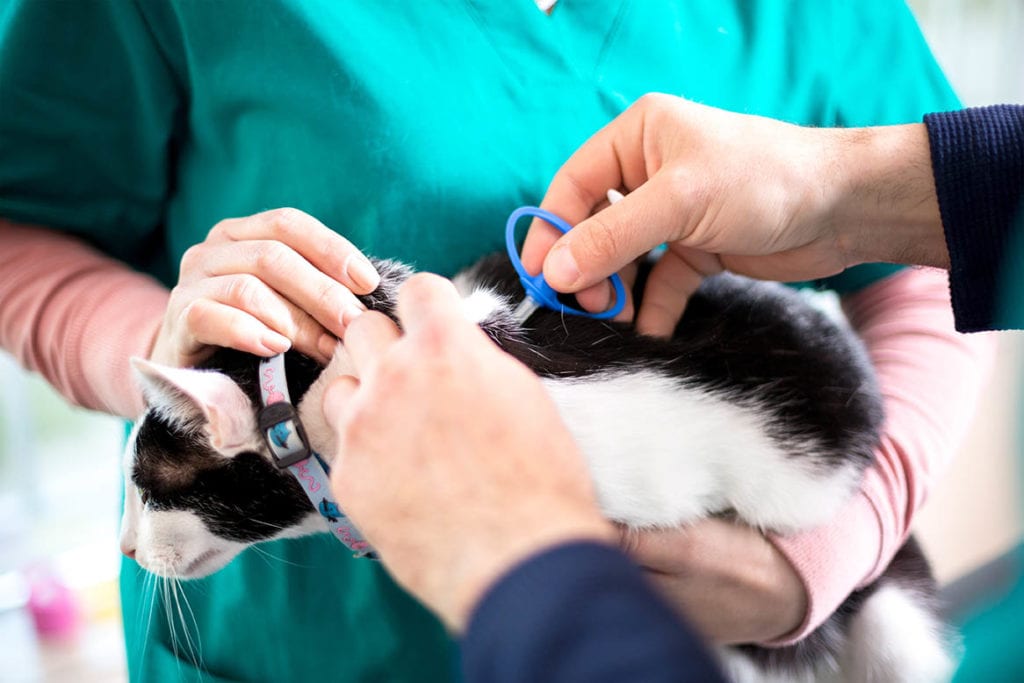
- 12. Collect Your Cat’s Medical Information
It’s vital to collect your cat’s medical information before you plan to leave and make sure you have a way to access it while you’re on the road in case they require veterinary care while you’re away from home.
Ensure you have all the documentation and certificates your cat needs to travel, including their vaccination status. Remember that the requirements vary based on where you’re headed and how you plan to travel.
- 13. Double Check Your Reservations
If you plan on staying in a hotel at your destination, contact the property ahead of time to ensure pets are permitted and get information about the rules and requirements that may apply. Don’t forget to inquire about the availability of litter boxes and food and water bowls.

- 14. Invest in Physical ID Tags
It’s best to attach an ID tag with your name and contact information to your cat’s collar. It will make it easy for people to reach out to you if your cat gets loose and makes a run for it.
Microchips are helpful , but lost cats need to be taken to shelters or veterinarians with scanners for their chips to be read. ID tags make the reunification process far more efficient; if your cat runs off, anyone who finds them can simply give you a call.

Traveling with cats can be stress-free with a bit of planning and preparation. Make sure to get started before you hit the road with your cat , particularly if you’re thinking about flying or staying in a hotel. Also, don’t forget to invest in an appropriate carrier and give your cat lots of time to get used to it.
- Hiking With a Cat: Is It Possible?
- Traveling With Kittens: Essential Tips
- https://vcahospitals.com/know-your-pet/flying-with-your-cat
- https://vcahospitals.com/know-your-pet/road-trips-and-car-travel-with-your-cat
- https://www.petmd.com/cat/care/8-tips-traveling-cat
- https://www.avma.org/resources-tools/pet-owners/petcare/traveling-your-pet-faq
- https://www.aa.com/i18n/travel-info/special-assistance/pets.jsp#:~:text=As%20recommended%20by%20the%20American,cardiovascular%20problems%20at%20high%20altitudes.
Featured Image Credit: Angels Relax CZ, Shutterstock
About the Author
Lorre Luther
Lorre Luther is a writer who is firmly convinced that cats are smarter than humans. She left her law career in the United States and moved to the Netherlands to follow her dream of becoming a writer. Lorre currently lives in Rotterdam, she enjoys traveling and greatly appreciates the beauty of nature. Lorre has a spot for animals and admires the intelligence of cats.

Zumalka Pet Supplement Review 2024: A Detailed Look

10 Pet-Friendly Hotels in St. George, Utah (2024 Update)

Does Health Monitoring Cat Litter Work? Vet Reviewed Facts & FAQ
Get catster in your inbox.

Here Comes the Sun: Is It Alright? Dangerous Things Cats Like

Cat Dogs: Cats for People Who Think They Don’t Like Cats

Strange Places That Cats Hide: Olga’s Preferred Spots
© pangolia pte. ltd. all rights reserved..

- Share full article
Advertisement
Supported by
Flying With Dogs or Cats? These Are Airlines’ Pet Policies
American recently relaxed its rules for pets traveling inside the cabin with their owners. Here’s what the major U.S. airlines require to travel with a pet.

By Jesus Jiménez
Flying with a pet can be expensive and confusing, with fees, weight limits, carrier size rules and the need to make sure there’s no loud barking (or meowing) on board.
Recently, American Airlines relaxed its pet policy to allow passengers to bring a carry-on bag in addition to a pet in a carrier, and more private flight options have been emerging in recent years for pet owners who can afford them.
Still, flying with large or medium-size dogs can be tricky, and many travelers are wary of leaving a pet in the plane’s cargo hold.
For those traveling on the major carriers with their pets as carry-ons, here’s what to know about each major domestic airline’s policy.
Southwest Airlines
On Southwest, a Dallas-based carrier, two checked bags can fly at no cost, but not pets. Southwest charges $125 per pet carrier on its flights.
Dogs or cats are allowed to travel below a seat in an approved carrier — up to 18.5 inches long by 8.5 inches high and 13.5 inches wide — according to the airline .
Southwest has a few caveats for those traveling with pets: The pet must stay in its carrier during the flight, and the carrier is considered a personal item or carry-on bag.
Up to six pets are allowed on Southwest flights. Once six pets are booked onto a flight, no further customers may add a pet companion to their booking.
United Airlines
United Airlines has no weight or breed restrictions for cats and dogs as long as they are in an approved hard or soft-sided carrier, measuring 17.5 inches long by 9 inches tall and 12 inches wide for a hard carrier, or 18 inches long by 11 inches tall and 11 inches wide for a soft carrier.
United charges $125 each way for travel with pets. There is no fee for service animals on United flights, but some forms are required before the flight.
The carrier must fit under a seat, and where a passenger is allowed to sit can vary according to the type of aircraft. For example, people traveling with pets cannot sit in emergency rows. If you’re traveling with two pets (the maximum allotted), you are required to book two seats.
Delta Air Lines
Small dogs and cats can travel on Delta Air Lines flights as long as they can fit inside a carrier stored below the seat. The size of the carrier depends on the aircraft, but in general the airline recommends a soft-sided carrier no larger than 18 inches long by 11 inches tall and 11 inches wide.
Your pet must be at least 8 weeks old and small enough to have some room to move around in the carrier, which must have ventilation openings on three sides.
Delta charges $95 for pets traveling as carry-on companions, and the passenger can bring only one personal item along with the pet. Certain seats cannot be booked for travel with an animal, such as those in an emergency exit row.
American Airlines
American Airlines allows cats and dogs to travel in a carry-on container, which must remain under the seat in front of the pet owner throughout the flight. The airline recommends a soft-sided carrier that measures 18 inches long by 11 inches tall and 11 inches wide.
The fee for a carry-on pet on a domestic American Airlines flight is $150.
Flights are limited to seven carry-on pets, not including service animals, and American Eagle flights are limited to five carry-on pets, with one in first class. There is no charge for service animals flying on American flight, but the airline requires forms to be filled out in advance.
The airline said in a statement that it had recently changed its cabin pet policy to allow customers with a pet to also bring either a personal item or carry-on bag stowed in the overhead bin (but not both).
“We made the change to provide a more convenient and comfortable experience to customers whose pets fly American,” the airline said.
Spirit, JetBlue, Frontier and Alaska
Spirit allows dogs and cats on its flights in a carrier no larger than 18 inches long by 14 inches wide and 9 inches tall for a fee of $125. The weight of the pet and the carrier cannot exceed 40 pounds, according to the airline .
Small dogs and cats can fly on JetBlue for fee of $125 each way , in an approved carrier. Up to six pets are allowed on JetBlue flights.
Frontier allows pets on board for a $99 fee each way, as long the pet fits in a carrier. Passengers can have only a personal item or carry-on in addition to their pet carrier.
Pets can travel in a carrier on Alaska Airlines flights for a fee of $100 each way. A passenger can travel with a pet carrier and a personal item, or a carrier and a carry-on bag.
Private or charter flights
Those who take their pets on private or charter flights, which can cost many thousands of dollars, have much more leeway. Dogs that weigh less than 150 pounds can sit on seats.
BarkAir, a charter operator tailored specifically for those flying with dogs, charges about $6,000 for a dog and its owner to travel, with flights between New York and Los Angeles and New York and London. Carriers are not required, and dogs can sit on laps, seats or beds.
Jesus Jiménez covers breaking news, online trends and other subjects. He is based in New York City. More about Jesus Jiménez
Open Up Your World
Considering a trip, or just some armchair traveling here are some ideas..
52 Places: Why do we travel? For food, culture, adventure, natural beauty? Our 2024 list has all those elements, and more .
Mumbai: Spend 36 hours in this fast-changing Indian city by exploring ancient caves, catching a concert in a former textile mill and feasting on mangoes.
Kyoto: The Japanese city’s dry gardens offer spots for quiet contemplation in an increasingly overtouristed destination.
Iceland: The country markets itself as a destination to see the northern lights. But they can be elusive, as one writer recently found .
Texas: Canoeing the Rio Grande near Big Bend National Park can be magical. But as the river dries, it’s getting harder to find where a boat will actually float .
Russia Travel Blog | All about Russia in English
- About our blog
- RussiaTrek.org
Sidebar →
- Architecture
- Entertainment
- RussiaTrek.org News

- Send us a tip with a message
- Support RussiaTrek.org
- Travel Guide to Ukraine
- Comments RSS
← Sidebar
The trains and stations of the Moscow Metro
2 Comments · Posted by Alex Smirnov in Cities , Travel , Video
The Moscow Metro is the third most intensive subway system in the world after Tokyo and Seoul subways. The first line was opened on May 15, 1935. Since 1955, the metro has the name of V.I. Lenin.
The system consists of 12 lines with a total length of 305.7 km. Forty four stations are recognized cultural heritage. The largest passenger traffic is in rush hours from 8:00 to 9:00 and from 18:00 to 19:00.
Cellular communication is available on most of the stations of the Moscow Metro. In March 2012, a free Wi-Fi appeared in the Circle Line train. The Moscow Metro is open to passengers from 5:20 to 01:00. The average interval between trains is 2.5 minutes.
The fare is paid by using contactless tickets and contactless smart cards, the passes to the stations are controlled by automatic turnstiles. Ticket offices and ticket vending machines can be found in station vestibules.
Tags: Moscow city
You might also like:

The bridge over Zolotoy Rog Bay in Vladivostok
The views of St. Petersburg from the TV tower >>
Tomás · August 27, 2012 at 11:34 pm
The Moscow metro stations are the best That I know, cars do not.
Alberto Calvo · September 25, 2016 at 8:57 pm
Great videos! Moscow Metro is just spectacular. I actually visited Moscow myself quite recently and wrote a post about my top 7 stations, please check it out and let me know what you think! :)
http://www.arwtravels.com/blog/moscow-metro-top-7-stations-you-cant-miss
Leave a Reply
XHTML: You can use these tags: <a href="" title=""> <abbr title=""> <acronym title=""> <b> <blockquote cite=""> <cite> <code> <del datetime=""> <em> <i> <q cite=""> <s> <strike> <strong>
- February 2024
- January 2024
- December 2023
- November 2023
- October 2023
- September 2023
- August 2023
- Bahasa Indonesia
- Slovenščina
- Science & Tech
- Russian Kitchen
A ride across passages of history - Moscow Metro rolls on

Click on the map to enlarge it
Lying at a depth of 5 (Pechatniki station) to 80 metres (Park Pobedy station), the history of the last eight decades unfold before your eyes, carved out of marble and granite and built in iron and glass – revealing the tastes, ideas, dreams, hopes and disappointments of the previous generations and contemporaries. The Moscow Metro dates back to 1931, when its construction first began, although engineers Pyotr Balinsky and Evgeny Knorre submitted their first designs to the Moscow City Duma as far back as 1902. “His speeches carried a strong temptation: like a true demon, he would promise to cast Moscow down to the bottom of the sea and raise it above the clouds”, a journalist for the Russkoye Slovo newspaper commented on Balinsky’s idea. Yet the Duma, made up of rich people, did not bite the bait: after all, they all lived in the centre of the city and never rode overcrowded trams.
After five failed proposals before the Duma, the Moscow Metro finally threw open its doors on May 15, 1935, 18 years after the revolution, and carried the first passengers on its moving staircases, escalators, and the padded seats of its new wagons (unlike the wooden seats in trams). The first metro line – from Sokolniki to Dvorets Sovetov (now known as Kropotkinskaya) -- was 11 km long and had 13 stations. Now, the Moscow Metro has a track of over 300 km with 12 lines and 182 stations. The city’s development outline for 2020 envisages that, by then, another 120 km will have been added to the existing routes.
For the first 20 years of its history, the Moscow Metro was named after Lazar Kaganovich, the “iron commissar” and Stalin’s right hand man, who was in-charge of construction of the first stage of the metro (incidentally, he personally blew up the Cathedral of Christ the Saviour in December 1931 as a part of the Proletarian Capital project). In 1955, however, the Metro was renamed after Vladimir Lenin. Although Russia has long since changed its political track, you can still find the images of the former leader at over 10 stations, including, for instance, busts of Lenin at Belorusskaya and Komsomolskaya stations, impressive mosaics at Baumanskaya and Kievskaya stations, a tile panel in the passage between the Borovitskaya and Biblioteka Imeni Lenina stations. By a bitter irony of fate, Lenin’s full-face and side-face images decorate the Tsaritsyno (translated as the Tsarina’s Estate) station (dubbed Lenino up until 1990) – images of the very person who ordered the shooting of the royal family. You will not, however, find any images of Stalin in Moscow’s underground. A symbol of Russia's victory, he was omnipresent in the late 1940s. After his death in 1953 and the denunciation of Stalin’s personality cult, his images were gradually withdrawn from the Moscow Metro.
“Architecture developed along the same lines, both above and below the surface. Anything that emerged above ground had a reflection underground. It is equally true that vice versa never occurred: good architecture underground but bad architecture above the ground,” says Nikolay Shumakov, chief architect of the Moscow Metro. The first metro stations, up until the mid-1950s, were conceived and built as luxurious “palaces for the people”, great architecture for a great state. Art historians insist that the richly-decorated underground was a deliberate ideological move to eulogise the young Soviet country. Stations built between 1937 and 1955 are characteristic of the first architectural period. Everything completed at this time is worthy of special attention. For instance, look at the ceiling at Mayakovskaya and Novokuznetskaya stations to see mosaic panels based on designs by artist Alexander Deineka – 24-Hour Soviet Sky and Heroic Labour of the Soviet People on the Home Front. The mosaics were assembled by famous mosaic artist Vladimir Frolov, author of the mosaic icons in St. Petersburg’s Church of the Saviour on Blood. The Ploshchad Revolutsii station was decorated with 76 bronze sculptures of workers, soldiers, farmers, students and other Soviet people. You can even find a frontier guard with a dog and rub its nose for good luck. You may also note that all the figures (except pioneers) are either sitting or bent, which engendered the sad joke – “Any Soviet man is either in jail or on his knees.”
Elements of decoration in Moscow's metro. Photos by Alexandr Ganyushin
1955 heralded the end of the good times for Russian architecture – both underground and above ground – after the Communist Party issued a decree "On elimination of extravagance in design and construction.” Dull stations, without any stucco work, mosaics, original columns or other “unjustified” elements, were built under the slogan “Kilometres at the expense of architecture”. Things were the same above the ground, where entire cities were built of commonplace five-storey apartment blocks, all looking the same, nicknamed ‘Khrushchevkas’ after the then leader, Nikita Khrushchev. To get a sense of this period’s architecture, see the few stations built in the 1960s-1980s like Tverskaya, Kitay-Gorod and Kolomenskaya. In 2002, with the reconstruction of the Vorobyovy Gory station, the development of the Moscow Metro entered a third stage, which could be defined as ‘renaissance’. The platform of the station offers a splendid view of the Moskva River, the Luzhniki Olympic Complex and the Academy of Sciences building. Architectural canons of the 1930s-1940s were once again in use in the design of underground stations. By the same token, artists once again become involved in decorating the stations. As such, the Sretensky Bulvar station boasts silhouettes of Pushkin, Gogol, and Timiryazev and Moscow sights; the Dostoevskaya station is decorated with black-and-white panels featuring the main characters from Dostoyevsky’s novels The Idiot, Demons, Crime and Punishment, The Brothers Karamazov, and the Maryina Roshcha station flaunts its pastoral mosaic landscapes. In 2004, Russia's first monorail transport system was launched into service – an elevated track (running 6 to 12 metres above the ground) in the northern part of Moscow, linking the All-Russian Exhibition Centre and the Timiryazevskaya metro station. The evolution of the Moscow Metro goes on. It’s still a work in progress, with ambitious plans to move the Moscow Metro even closer to passengers over the next ten years, not just by adding an extra 120 km to its total track. “We want to strip the stations of everything we can,” says Nikolai Shumakov. “We are trying to show the passengers their very framework, what the metro is made of. Cast iron and concrete are beautiful.”
Joy ride: Read Gogol, Dante or savour art

The Aquarelle Train. Source: Reuters/Vostock-Photo
With any luck, you can ride in a retro train, a moving art gallery or a library. The trains are actually a part of the general traffic (i.e., they do not run to any special schedule) and are used on certain lines. The Reading Moscow Train , an ordinary train on the face of it, features extracts from literary works for adults and children. Each wagon has its own selection, from children’s fairy tales to Gogol. Circle Line. The Poetry in Metro Train carries an exposition, updated this year, dedicated to Italian poets Dante Alighieri, Francesco Petrarch, Giacomo Leopardi, etc. All the poems are featured in two languages, Russian and Italian. Filevskaya Line. The Sokolniki Retro Train looks exactly like the first Moscow Metro train, both inside and out. Painted brown, it has padded seats, typical wall decorations and retro lamps. Sokolnicheskaya Line. The Aquarelle Train looks like a cabinet painted with flowers and fruit on the outside. Inside, it is an art gallery featuring art reproductions from the Vyatka Apollinary and Viktor Vasnetsov Art Museum. Arbatsko-Pokrovskaya Line.
Revolution Square station (built in 1938) is close to the Red Square area. There are 72 sculptures in the station, depicting the people of the Soviet Union, including soldiers, farmers, athletes, writers, industrial workers and school children.
All rights reserved by Rossiyskaya Gazeta.
to our newsletter!
Get the week's best stories straight to your inbox
This website uses cookies. Click here to find out more.
- Car Rentals
- Airport Transfers
- Attractions & Tours
- Bundle & Save
- Destinations
- Trip.com Rewards
How to Buy Cheap China Train Tickets for Foreigners - Easy China Train Booking

by Trip.com
April 24, 2024

Various Methods for China Train Booking
There are various methods to buy China train tickets, both online booking and offline options are available to cater to residents and international travelers . Check out the common ways for China train booking:
Requirements for Foreigners to Buy China Train Tickets

- 1. Passport: International travelers must have a valid passport. When purchasing a ticket, you will need to provide your passport number and other relevant details.
- 2. Visa: Depending on your nationality, you may need a valid Chinese visa to enter and travel within China.
- 3. Real-name Registration: China's train ticketing system requires real-name registration. This means that the name on the ticket must match the name on the traveler's passport exactly.
Best Way of China Train Booking
How to book china train tickets on trip.com, guide to china train booking on trip.com website.

Guide to China Train Booking on Trip.com App
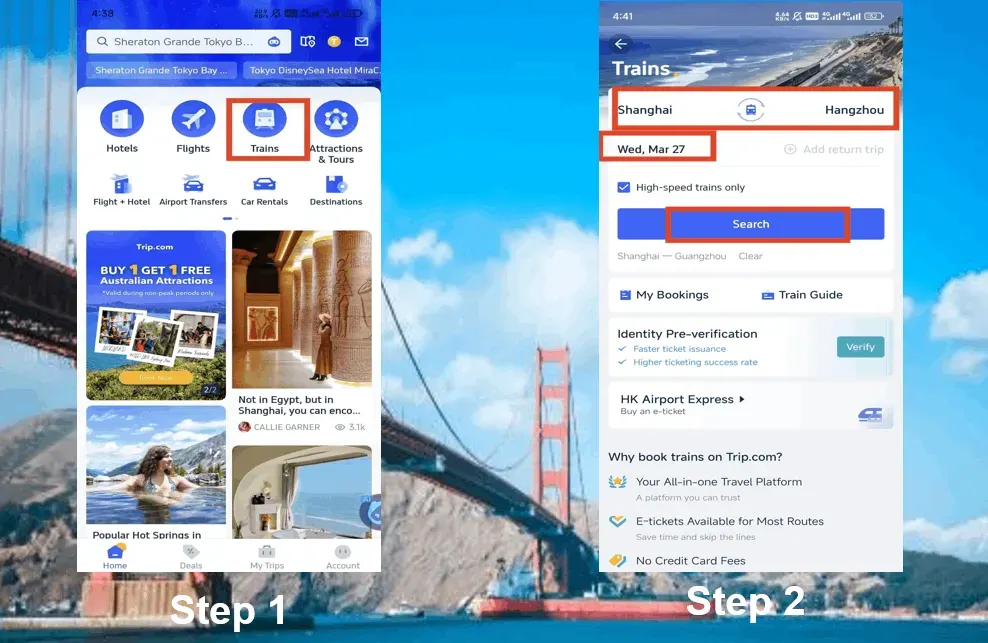
China Train Booking Tips

China train booking can be a straightforward process if you know the right steps to take. Here are some tips to help you book train tickets in China:
1. Plan Ahead: China Train tickets can be purchased up to 15 days in advance . During peak travel times, such as Chinese New Year, National Day (October 1st), tickets can sell out quickly. It's best to plan your trip and book your tickets as early as possible.
2. Plan Your Travel with Trip.com: You can book train tickets through Trip.com, which offer English interfaces and accept international credit cards, but they may charge a small service fee.
3. Know Your Train Types and Classes: China has different types of trains, including high-speed trains (G and D category), express trains (Z category), and regular trains (T, K, and other categories). High-speed trains are faster and more comfortable but also more expensive.
4. Understand the Seat Classes: High speed train generally offers 3 types of seat classes : second class, first class, and business class. Regular China trains offers hard seat, hard sleeper, and soft sleeper. Choose the type and class that best fits your budget and comfort preferences.
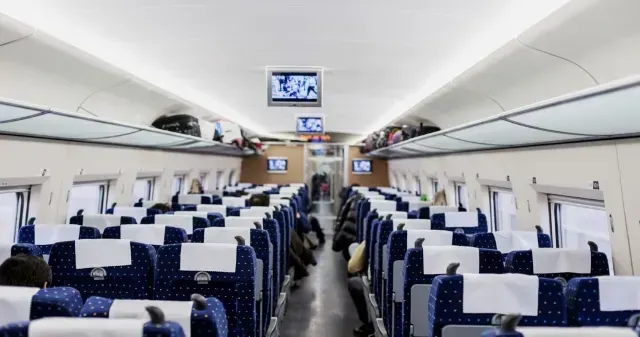
5. Have Your Passport Ready: When booking a train ticket, you'll need to provide your passport number and other personal information. You'll also need your passport when picking up your ticket and boarding the train.
6. Choose Your Seat: If you're booking a high-speed train, you'll often have the option to select a seat. Window seats offer better views, while aisle seats allow for easier movement. If you're traveling with others, try to book seats together.
7. Ticket Pickup and E-Tickets: After booking online, you can pick up your physical ticket at any railway station in China or use an automatic ticket machine if you have a Chinese ID card. Some routes and booking platforms also offer e-ticket options, where you can use your passport directly to board the train without needing a physical ticket.

8. Arrive Early: Train stations in China can be large and crowded. Arrive at least an hour before your departure time to navigate the station, go through security checks, and find your waiting area and platform.
9. Baggage Allowance: Be aware of the baggage allowance on Chinese trains. Each passenger is typically allowed to carry up to 20 kg (44 lbs) of luggage, with the total dimension of each item not exceeding 160 cm .
10. Food and Drinks: Most high-speed trains have a dining car and offer cart service with snacks and drinks. You can also bring your own food and non-alcoholic beverages on board.
11. Cancellation and Changes: If your plans change, you can cancel or modify your ticket before departure. The rules and fees for changes and cancellations vary, so check the terms and conditions when you book.
12. Keep Your Ticket: Keep your ticket with you throughout the journey, as you may need it to exit the station at your destination.
13. Download a Translation App: If you don't speak Mandarin, a translation app can be invaluable for communication in train stations or with staff.
14. Respect Local Etiquette: Be mindful of local customs and etiquette on trains, such as not speaking loudly on your phone and keeping your area clean.
FAQs about China Train Booking
What're the payment methods for china train booking, how far in advance can i book train tickets in china, how do i collect my china train tickets, can i travel with a pet on a chinese train.
China Train Booking Guide
- 1. Various Methods for China Train Booking
- 2. Requirements for Foreigners to Buy China Train Tickets
- 3. Best Way of China Train Booking
- 4. How to book China Train Tickets on Trip.com
- 5. China Train Booking Tips
<h3>Trending Searches</h3>
More about China Trains
- China High Speed Rail
- China Train Ticket
- China Train Map
- China Train Booking
- cheap hotels in ocean city md
- The Cosmopolitan of Las Vegas Booking
- Key West all Inclusive Resorts
- Serviced apartment
- Indoor Activities in Tokyo
- Customer Support
- Service Guarantee
- More Service Info
- Website Feedback
- About Trip.com
- Terms & Conditions
- Privacy Statement
- About Trip.com Group
Trains Moscow to Elektrostal: Times, Prices and Tickets
- Train Times
- Seasonality
- Accommodations
Moscow to Elektrostal by train
The journey from Moscow to Elektrostal by train is 32.44 mi and takes 2 hr 7 min. There are 71 connections per day, with the first departure at 12:15 AM and the last at 11:46 PM. It is possible to travel from Moscow to Elektrostal by train for as little as or as much as . The best price for this journey is .
Get from Moscow to Elektrostal with Virail
Virail's search tool will provide you with the options you need when you want to go from Moscow to Elektrostal. All you need to do is enter the dates of your planned journey, and let us take care of everything else. Our engine does the hard work, searching through thousands of routes offered by our trusted travel partners to show you options for traveling by train, bus, plane, or carpool. You can filter the results to suit your needs. There are a number of filtering options, including price, one-way or round trip, departure or arrival time, duration of journey, or number of connections. Soon you'll find the best choice for your journey. When you're ready, Virail will transfer you to the provider's website to complete the booking. No matter where you're going, get there with Virail.
How can I find the cheapest train tickets to get from Moscow to Elektrostal?
Prices will vary when you travel from Moscow to Elektrostal. On average, though, you'll pay about for a train ticket. You can find train tickets for prices as low as , but it may require some flexibility with your travel plans. If you're looking for a low price, you may need to prepare to spend more time in transit. You can also often find cheaper train tickets at particular times of day, or on certain days of the week. Of course, ticket prices often change during the year, too; expect to pay more in peak season. For the lowest prices, it's usually best to make your reservation in advance. Be careful, though, as many providers do not offer refunds or exchanges on their cheapest train tickets. Unfortunately, no price was found for your trip from Moscow to Elektrostal. Selecting a new departure or arrival city, without dramatically changing your itinerary could help you find price results. Prices will vary when you travel from Moscow to Elektrostal. On average, though, you'll pay about for a train ticket. If you're looking for a low price, you may need to prepare to spend more time in transit. You can also often find cheaper train tickets at particular times of day, or on certain days of the week. Of course, ticket prices often change during the year, too; expect to pay more in peak season. For the lowest prices, it's usually best to make your reservation in advance. Be careful, though, as many providers do not offer refunds or exchanges on their cheapest train tickets.
How long does it take to get from Moscow to Elektrostal by train?
The journey between Moscow and Elektrostal by train is approximately 32.44 mi. It will take you more or less 2 hr 7 min to complete this journey. This average figure does not take into account any delays that might arise on your route in exceptional circumstances. If you are planning to make a connection or operating on a tight schedule, give yourself plenty of time. The distance between Moscow and Elektrostal is around 32.44 mi. Depending on the exact route and provider you travel with, your journey time can vary. On average, this journey will take approximately 2 hr 7 min. However, the fastest routes between Moscow and Elektrostal take 1 hr 3 min. If a fast journey is a priority for you when traveling, look out for express services that may get you there faster. Some flexibility may be necessary when booking. Often, these services only leave at particular times of day - or even on certain days of the week. You may also find a faster journey by taking an indirect route and connecting in another station along the way.
How many journeys from Moscow to Elektrostal are there every day?
On average, there are 71 daily departures from Moscow to Elektrostal. However, there may be more or less on different days. Providers' timetables can change on certain days of the week or public holidays, and many also vary at particular times of year. Some providers change their schedules during the summer season, for example. At very busy times, there may be up to departures each day. The providers that travel along this route include , and each operates according to their own specific schedules. As a traveler, you may prefer a direct journey, or you may not mind making changes and connections. If you have heavy suitcases, a direct journey could be best; otherwise, you might be able to save money and enjoy more flexibility by making a change along the way. Every day, there are an average of 18 departures from Moscow which travel directly to Elektrostal. There are 53 journeys with one change or more. Unfortunately, no connection was found for your trip from Moscow to Elektrostal. Selecting a new departure or arrival city, without dramatically changing your itinerary could help you find connections.
Book in advance and save
If you're looking for the best deal for your trip from Moscow to Elektrostal, booking train tickets in advance is a great way to save money, but keep in mind that advance tickets are usually not available until 3 months before your travel date.
Stay flexible with your travel time and explore off-peak journeys
Planning your trips around off-peak travel times not only means that you'll be able to avoid the crowds, but can also end up saving you money. Being flexible with your schedule and considering alternative routes or times will significantly impact the amount of money you spend on getting from Moscow to Elektrostal.
Always check special offers
Checking on the latest deals can help save a lot of money, making it worth taking the time to browse and compare prices. So make sure you get the best deal on your ticket and take advantage of special fares for children, youth and seniors as well as discounts for groups.
Unlock the potential of slower trains or connecting trains
If you're planning a trip with some flexible time, why not opt for the scenic route? Taking slower trains or connecting trains that make more stops may save you money on your ticket – definitely worth considering if it fits in your schedule.
Best time to book cheap train tickets from Moscow to Elektrostal
The cheapest Moscow - Elektrostal train tickets can be found for as low as $35.01 if you’re lucky, or $54.00 on average. The most expensive ticket can cost as much as $77.49.
Find the best day to travel to Elektrostal by train
When travelling to Elektrostal by train, if you want to avoid crowds you can check how frequently our customers are travelling in the next 30-days using the graph below. On average, the peak hours to travel are between 6:30am and 9am in the morning, or between 4pm and 7pm in the evening. Please keep this in mind when travelling to your point of departure as you may need some extra time to arrive, particularly in big cities!
Moscow to Elektrostal CO2 Emissions by Train

Anything we can improve?
Frequently Asked Questions
Go local from moscow, trending routes, weekend getaways from moscow, international routes from moscow and nearby areas, other destinations from moscow, other popular routes.

An official website of the United States government
Here’s how you know
Official websites use .gov A .gov website belongs to an official government organization in the United States.
Secure .gov websites use HTTPS A lock ( Lock A locked padlock ) or https:// means you’ve safely connected to the .gov website. Share sensitive information only on official, secure websites.
TSA explosives detection canine retires from his job screening travelers at Reagan National Airport

ARLINGTON, Va. – Messi, an 8-year-old Yellow Labrador Retriever, has had his last run as a Transportation Security Administration (TSA) passenger screening canine at Ronald Reagan Washington National Airport.
The dog is ready to trade in his working vest for afternoons lounging on the sofa.
Messi’s claim to fame is that last year he was featured in the free annual downloadable annual TSA canine calendar. He was featured as the dog of the month for February.
He was clearly born to work for TSA because he enjoys watching airplanes and playing in the grass at nearby Gravelly Point. Messi is a lovable and hard-working dog who has enjoyed playing with a tennis ball after a busy day sniffing for any traces of explosives at the airport. Now he doesn’t have to wait to play with his favorite toy.
After his last morning of sniffing for any traces of explosives at Reagan National Airport this morning, Messi was joined by several of the canine handlers and invited guests to celebrate his retirement at a surprise party. A training aid was concealed in a large room and Messi, along with his handler, Peter, searched the room. When Messi “hit” on the device, he was showered with tennis balls tossed his way by the other canine handlers. Messi was thrilled !
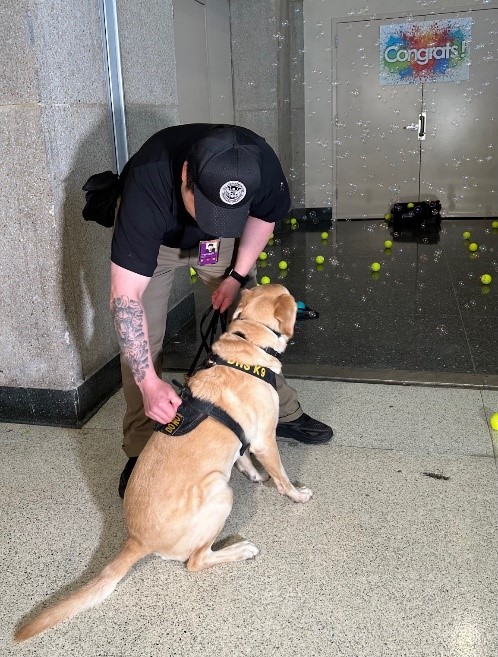
Peter then removed Messi’s “Do Not Pet” patch from his harness, thus officially signaling that the dog was no longer a working canine and could be petted. There was no shortage of guests who were eager to pet the newly retired dog.
Peter is adopting Messi in his retirement so the two will continue to stay together. As for Peter, he is shifting gears from being a canine handler to a canine trainer.
TSA trains each of its explosives detection canines at the TSA Canine Training Center, located at Joint Base San Antonio - Lackland in San Antonio, Texas. Considered the “Center for Excellence” for explosives detection canine training, the TSA National Explosives Detection Canine Team Program is the Department of Homeland Security’s largest explosives detection canine program.
About 300 canines complete the training annually. Each canine recruit spends 16 weeks in training where they meet their handlers, socialize to adapt to busy airport environments, and learn their craft of detecting a variety of explosive odors before reporting to their duty stations.
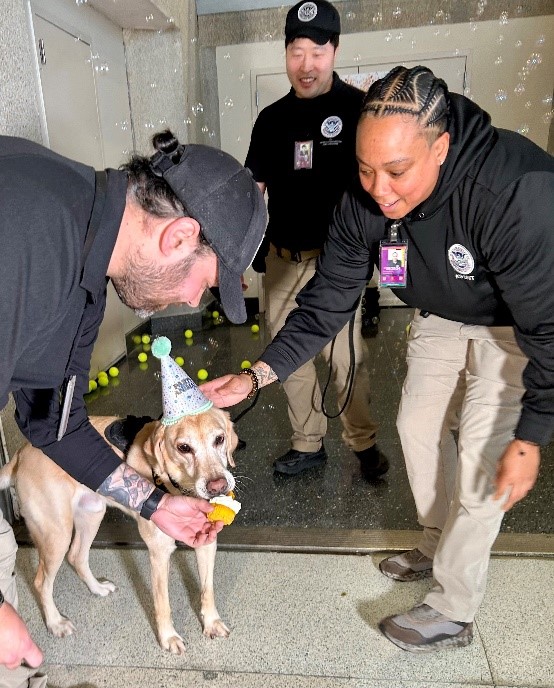
TSA has more than 1,000 canine handler teams deployed in support of security and screening operations nationwide. The explosives detection canine teams inspect passengers and all areas in and around terminals. They are so effective at their jobs that other public and private sector law enforcement agencies often request their support for similar security missions.
Each canine and their handler serves as a reliable resource for detecting explosives as well as providing a visible deterrent to terrorism directed towards various types of transportation nodes. Once on duty, these canines work to safeguard passengers and cargo across the nation’s transportation systems.

IMAGES
VIDEO
COMMENTS
Passengers will certify that their pet is up-to-date with all required vaccinations before travel. Booking Procedure. Pets can be booked onto a reservation at Amtrak.com or by calling 800-USA-RAIL. Bookings can also be made in person at an Amtrak ticket desk. Hot Tip: Pets can travel on board Amtrak services for $26. Train Systems that Allow Pets
The route you are traveling will determine where you sit. Some trains have a pet-friendly coach car; others allow you to sit in any coach car. If the train has a pet-friendly quiet car, consider sitting there as there will be less noise and fewer distractions. If possible, avoid peak travel times and rush hours for the best experience.
VIA Rail Canada allows pets - only small dogs and cats - to travel in cars with their owners as long as the animals are small enough to fit comfortably in a carrier that meets VIA Rail carrier standards. The total weight of the carrier and animal must not exceed 10 kilograms (22 lb.). This pet travel by train policy applies only on Corridor ...
To add a pet fare, first book a regular Amtrak ticket through Wanderu, after which you have a couple of options. One is to go to Amtrak and click "Modify Trip" in the top right-hand corner. From there, you'll be able to add your pet and pay the necessary fee. Alternatively, you can call Amtrak customer service at +1 (800) 872-7245, and ...
The FI dog collar is a high-tech gadget with advanced tracking features. It provides an extra layer of assurance, helping monitor your pet's safety and activity levels during train journeys, ensuring comfortable travel, and adhering to etiquette. Plan pet-friendly train journeys with our ultimate guide. Learn about policies, preparation, and ...
Only 5 pets are allowed per train, so make reservations as early as you can. To do so, either head over to Amtrak.com, call the reservation number (1-800-USA-RAIL) or visit a staffed station. Other rules to keep in mind: You can bring only 1 pet on board per passenger. Pets are allowed only in coach class.
Pet Travel by Train: Amtrak offers new program to transport small dogs and cats Amtrak also service animals to travel with their disadvantaged owners on all routes. Additionally and with great success, Amtrak has been permanently expanding the number of routes that will accept pets under the following conditions: One pet per passenger for ...
Planning a Train Trip with Your Pet Choosing Pet-Friendly Train Routes. When it comes to train travel with our furry friends, we're all about finding routes that welcome them with open arms—or paws. Not all train lines are created equal in the pet-friendly department, which means doing a bit of assignments is essential.
We have the pet train travel information you need to feel comfortable with your transit choice. The below sections have essential costs, pet policies, carrier information, and service animal policies for both national and regional rail systems. Amtrak is the only nationwide passenger train, and its pet policies are surprisingly friendly. Regional commuter trains and other forms of rail transit ...
Step 1. Research or contact the train operator on which you are planning to travel to find out if pets are permitted on the train. If they don't, look into another train system, if available ...
Otherwise, small dogs and cats (20lbs or less) are permitted on Downeaster Trains in a pet carrier. Pet reservations are required and can be made online, at a staffed station or by calling 1-800-USA-RAIL / 1-800-872-7245. $25 or 800 Amtrak points for each travel segment. Service animals are allowed.
Domestic animals in pet carriers and larger dogs are permitted on board the TGV and require a ticket for travel. Guide dogs travel for free on any train. The cost of the pet fare depends on the size and weight of the animal. Small dogs or other domestic animals (less than 6kg) can be carried in a bag or basket not exceeding 45cm x 30cm x 25cm.
Before you go, you may need to complete certain paperwork or tasks, such as getting a health certificate for your pet. Meeting these requirements takes time, so contact your veterinarian for help as soon as you decide to travel (whether by plane, car, boat, train, or other means).
Spain: Small animals are allowed. Pets over 10kg are not allowed onboard trains in Spain. France: Pets are allowed on board. There are small charges for dogs/other animals in cages. Larger dogs on leads pay half a standard class fare. Italy: Dogs and other pets are permitted on most trains.
Pets can travel on Indian railways, but there are certain conditions and restrictions. Only dogs, cats, and birds are permitted as pets on trains. Pets are only allowed to travel in AC first-class and first-class compartments. Each passenger is allowed to carry a maximum of two pet dogs, cats, or birds. The pets must be clean, healthy, and free ...
Tickets subject to cancellation fee. Dogs, cats, pet rabbits and rodents, birds, reptiles and amphibians under 6kg must travel in a carrier measuring less than 45 x30 x 25cm. The fare for small pets is 7€ on TGV, intercity and TER trains. If your pet weighs more than 6kg, it must be muzzled all times.
A pet must travel with its human counterpart on a train. Only dogs and cats are allowed to travel as pets on Amtrak, and pets must be at least eight weeks old and up to date on all vaccinations.
If you want to travel with more animals than that, there may be an additional fee. Please contact your train company for more information. Leads and pet carriers. Both on the train and at stations, we kindly ask you to keep your dog on a lead or in a pet carrier - whichever you and your furry friend prefer.
Only one animal is allowed per traveler. As for the price, it differs from country to country. For travel to Switzerland, Germany, Italy, Spain and Belgium (Brussels): You must pay €7 for a small pet traveling in a container. You must pay €20 for a dog on a leash. For TGV France Luxembourg and TGV France-Fribourg, a single fare applies ...
The 14 Tips to Travel with a Cat. 1. Invest in a Good Carrier. Cats should always be restrained when riding in cars, and airports require them to stay in their carriers at all times (except during ...
Pets can travel in a carrier on Alaska Airlines flights for a fee of $100 each way. A passenger can travel with a pet carrier and a personal item, or a carrier and a carry-on bag.
2 Comments · Posted by Alex Smirnov in Cities, Travel, Video. The Moscow Metro is the third most intensive subway system in the world after Tokyo and Seoul subways. The first line was opened on May 15, 1935. Since 1955, the metro has the name of V.I. Lenin. ... In March 2012, a free Wi-Fi appeared in the Circle Line train. The Moscow Metro is ...
7 mn people travel by metro every day, the highest figure in the world. The most loaded stations serve 100-150,000 passengers daily. The most loaded stations serve 100-150,000 passengers daily.
5. Have Your Passport Ready: When booking a train ticket, you'll need to provide your passport number and other personal information.You'll also need your passport when picking up your ticket and boarding the train. 6. Choose Your Seat: If you're booking a high-speed train, you'll often have the option to select a seat.Window seats offer better views, while aisle seats allow for easier movement.
The journey from Moscow to Elektrostal by train is 32.44 mi and takes 2 hr 7 min. There are 71 connections per day, with the first departure at 12:15 AM and the last at 11:46 PM. It is possible to travel from Moscow to Elektrostal by train for as little as or as much as . The best price for this journey is . Journey Duration.
Drive • 1h 3m. Drive from Elektrostal to Moscow 58.6 km. RUB 450 - RUB 700. Quickest way to get there Cheapest option Distance between.
ARLINGTON, Va. - Messi, an 8-year-old Yellow Labrador Retriever, has had his last run as a Transportation Security Administration (TSA) passenger screening canine at Ronald Reagan Washington National Airport. The dog is ready to trade in his working vest for afternoons lounging on the sofa. Messi's claim to fame is that last year he was featured in the free annual downloadable annual TSA ...